- Link to facebook
- Link to linkedin
- Link to twitter
- Link to youtube
- Writing Tips

How to Outline Expenses/Budget in Your Dissertation Plan

4-minute read
- 9th May 2023
When drafting your dissertation outline plan , there’s a lot to consider. One crucial section not to overlook is your budget and expenses. A comprehensive budget shows that you have thought through your study thoroughly and are prepared to execute your research plan successfully. Here, we’ll go through the steps you’ll need to take to craft a budget, including a few examples of common budget structures.
Steps to Take to Create Your Budget
1. consult your adviser, committee members, and funding sources for guidelines.
The source or sources responsible for funding your dissertation research will likely have guidelines on what is and isn’t a billable expense. Before defining your projected costs, check your funding organization’s specifications on allowable expenses. It can also help to speak with your adviser and potentially other dissertation committee members about the specifics and general guidelines to ensure everyone’s on the same page when it comes to your anticipated costs.
2. List All of the Costs Associated With Implementing Your Desired Dissertation Plan
Depending on your type of research, setting, and particular project, a wide range of items might be appropriate to add to your budget. Go through your dissertation project plan from beginning to end and list all of the required tasks, along with who will complete them, to ensure you don’t miss any expenses. Although the list below is not comprehensive, and your items might vary depending on your research project, some standard costs to consider are:
● Salaries and wages for all personnel involved in the project (including time and other resources that will be expected from your adviser and committee members).
● Equipment and lab fees.
● Recruitment costs for study participants.
● Participant compensation.
● Software costs for data collection, storage, and analysis.
● Office supplies (including any printing of recruitment materials, study information pamphlets, or conference posters).
● Travel (including transport to and from field sites, conference registration fees, transportation, lodging, and meals).
● Journal or conference submission and publication fees for papers created from your dissertation research.
Find this useful?
Subscribe to our newsletter and get writing tips from our editors straight to your inbox.
● Costs involved with writing, editing, and proofreading services for your dissertation .
Additionally, while it’s advisable to work within the constructs of your funding sources, don’t sell your research study short. After writing down all of the essential costs needed to complete your research plan, ask yourself how you would use any further financial backing. Could you make a good argument as to why supplementary funding would add significant value to your work? If so, consider adding these line items to your budget as well. If you have to negotiate your budget, you can always circle back and reconsider these extra items.
3. Construct Your Budget
The institution overseeing your dissertation project might require your budget to be submitted in a specified structure or template. However, if this isn’t the case, there are several possible approaches to organizing and presenting it – just make sure to check with your institution for any specific guidelines or requirements.
A standard request is to list your expenses by grouping them into direct costs , such as equipment, travel, and wages for people working on the project, and indirect costs , which are expenses that aren’t solely associated with your research project, such as general administration, utilities, and the use of shared services or spaces like libraries. It’s also common to arrange your direct and indirect costs into a Line-Item Budget (LIB) , which simply means that you list each of your projected expenses as a line in your budget.
There are many types of budget templates available for free online. Some designs will include a column to provide more details about each item, while other approaches will list the justifications for the expenses at the end. If you have multiple funding sources, it may be helpful to have columns for each funder and the percentage or amount of each expense they will be expected to be responsible for. Some templates will calculate the total costs for you , but no matter which presentation method you choose, make sure your costs are entered and totaled correctly.
Although the individual items will vary from project to project, these three steps will lead you on your way to preparing a persuasive proposal budget:
● Consult your adviser, committee members, and funding sources for guidelines.
● List all the costs associated with implementing your desired dissertation plan (including the items you hope to get funded if they are justifiable).
● Construct your budget with direct and indirect costs with justifications for each using an appropriate template and confirm your expenses are calculated correctly.
We wish you the best of luck with your budget writing and dissertation proposal. For more help, check out our comprehensive Dissertation Writing Guide . And if you’re interested in using our services here at Proofed, you can try them for free .
Share this article:
Post A New Comment
Got content that needs a quick turnaround? Let us polish your work. Explore our editorial business services.
9-minute read
How to Use Infographics to Boost Your Presentation
Is your content getting noticed? Capturing and maintaining an audience’s attention is a challenge when...
8-minute read
Why Interactive PDFs Are Better for Engagement
Are you looking to enhance engagement and captivate your audience through your professional documents? Interactive...
7-minute read
Seven Key Strategies for Voice Search Optimization
Voice search optimization is rapidly shaping the digital landscape, requiring content professionals to adapt their...
Five Creative Ways to Showcase Your Digital Portfolio
Are you a creative freelancer looking to make a lasting impression on potential clients or...
How to Ace Slack Messaging for Contractors and Freelancers
Effective professional communication is an important skill for contractors and freelancers navigating remote work environments....
3-minute read
How to Insert a Text Box in a Google Doc
Google Docs is a powerful collaborative tool, and mastering its features can significantly enhance your...

Make sure your writing is the best it can be with our expert English proofreading and editing.
The Research Whisperer
Just like the thesis whisperer – but with more money, how to make a simple research budget.

Every research project needs a budget*.
If you are applying for funding, you must say what you are planning to spend that funding on. More than that, you need to show how spending that money will help you to answer your research question .
So, developing the budget is the perfect time to plan your project clearly . A good budget shows the assessors that you have thought about your research in detail and, if it is done well, it can serve as a great, convincing overview of the project.
Here are five steps to create a simple budget for your research project.
1. List your activities
Make a list of everything that you plan to do in the project, and who is going to do it.
Take your methodology and turn it into a step-by-step plan. Have you said that you will interview 50 people? Write it on your list.
Are you performing statistical analysis on your sample? Write it down.
Think through the implications of what you are going to do. Do you need to use a Thingatron? Note down that you will need to buy it, install it, and commission it.
What about travel? Write down each trip separately. Be specific. You can’t just go to ‘South East Asia’ to do fieldwork. You need to go to Kuala Lumpur to interview X number of people over Y weeks, then the same again for Singapore and Jakarta.
Your budget list might look like this:
- I’m going to do 10 interviews in Kuala Lumpur; 10 interviews in Singapore; 10 interviews in Jakarta by me.
- I’ll need teaching release for three months for fieldwork.
- I’ll need Flights to KL, Singapore, Jakarta and back to Melbourne.
- I’ll need Accommodation for a month in each place, plus per diem.
- The transcription service will transcribe the 30 interviews.
- I’ll analysis the transcribed results. (No teaching release required – I’ll do it in my meagre research time allowance.)
- I’ll need a Thingatron X32C to do the trials.
- Thing Inc will need to install the Thingatron. (I wonder how long that will take.)
- The research assistant will do three trials a month with the Thingatron.
- I’ll need to hire a research assistant (1 day per week for a year at Level B1.)
- The research assistant will do the statistical analysis of the Thingatron results.
- I’ll do the writing up in my research allowance time.
By the end, you should feel like you have thought through the entire project in detail. You should be able to walk someone else through the project, so grab a critical friend and read the list to them. If they ask questions, write down the answers.
This will help you to get to the level of specificity you need for the next step.
2. Check the rules again
You’ve already read the funding rules, right? If not, go and read them now – I’ll wait right here until you get back.
Once you’ve listed everything you want to do, go back and read the specific rules for budgets again. What is and isn’t allowed? The funding scheme won’t pay for equipment – you’ll need to fund your Thingatron from somewhere else. Cross it off.
Some schemes won’t fund people. Others won’t fund travel. It is important to know what you need for your project. It is just as important to know what you can include in the application that you are writing right now.
Most funding schemes won’t fund infrastructure (like building costs) and other things that aren’t directly related to the project. Some will, though. If they do, you should include overheads (i.e. the general costs that your organisation needs to keep running). This includes the cost of basics like power and lighting; desks and chairs; and cleaners and security staff. It also includes service areas like the university library. Ask your finance officer for help with this. Often, it is a percentage of the overall cost of the project.
If you are hiring people, don’t forget to use the right salary rate and include salary on-costs. These are the extra costs that an organisation has to pay for an employee, but that doesn’t appear in their pay check. This might include things like superannuation, leave loading, insurance, and payroll tax. Once again, your finance officer can help with this.
Your budget list might now look like this:
- 10 interviews in Kuala Lumpur; 10 interviews in Singapore; 10 interviews in Jakarta by me.
- Teaching release for three months for fieldwork.
- Flights to KL, Singapore, Jakarta and back to Melbourne.
- Accommodation for a month in each place, plus per diem, plus travel insurance (rule 3F).
- Transcription of 30 interviews, by the transcription service.
- Analysis of transcribed results, by me. No teaching release required.
- Purchase and install Thingatron X32C, by Thing Inc . Not allowed by rule 3C . Organise access to Thingatron via partner organistion – this is an in-kind contribution to the project.
- Three trials a month with Thingatron, by research assistant.
- Statistical analysis of Thingatron results, by research assistant.
- Research assistant: 1 day per week for a year at Level B1, plus 25.91% salary on-costs.
- Overheads at 125% of total cash request, as per rule 3H.
3. Cost each item
For each item on your list, find a reasonable cost for it . Are you going to interview the fifty people and do the statistical analysis yourself? If so, do you need time release from teaching? How much time? What is your salary for that period of time, or how much will it cost to hire a replacement? Don’t forget any hidden costs, like salary on-costs.
If you aren’t going to do the work yourself, work out how long you need a research assistant for. Be realistic. Work out what level you want to employ them at, and find out how much that costs.
How much is your Thingatron going to cost? Sometimes, you can just look that stuff up on the web. Other times, you’ll need to ring a supplier, particularly if there are delivery and installation costs.
Jump on a travel website and find reasonable costs for travel to Kuala Lumpur and the other places. Find accommodation costs for the period that you are planning to stay, and work out living expenses. Your university, or your government, may have per diem rates for travel like this.
Make a note of where you got each of your estimates from. This will be handy later, when you write the budget justification.
- 10 interviews in Kuala Lumpur; 10 interviews in Singapore; 10 interviews in Jakarta by me (see below for travel costs).
- Teaching release for three months for fieldwork = $25,342 – advice from finance officer.
- Flights to KL ($775), Singapore ($564), Jakarta ($726), Melbourne ($535) – Blue Sky airlines, return economy.
- Accommodation for a month in each place (KL: $3,500; Sing: $4,245; Jak: $2,750 – long stay, three star accommodation as per TripAdviser).
- Per diem for three months (60 days x $125 per day – University travel rules).
- Travel insurance (rule 3F): $145 – University travel insurance calculator .
- Transcription of 30 interviews, by the transcription service: 30 interviews x 60 minutes per interview x $2.75 per minute – Quote from transcription service, accented voices rate.
- Analysis of transcribed results, by me. No teaching release required. (In-kind contribution of university worth $2,112 for one week of my time – advice from finance officer ).
- Purchase and install Thingatron X32C, by Thing Inc . Not allowed by rule 3C. Organise access to Thingatron via partner organistion – this is an in-kind contribution to the project. ($2,435 in-kind – quote from partner organisation, at ‘favoured client’ rate.)
- Research assistant: 1 day per week for a year at Level B1, plus 25.91% salary on-costs. $12,456 – advice from finance officer.
Things are getting messy, but the next step will tidy it up.
4. Put it in a spreadsheet
Some people work naturally in spreadsheets (like Excel). Others don’t. If you don’t like Excel, tough. You are going to be doing research budgets for the rest of your research life.
When you are working with budgets, a spreadsheet is the right tool for the job, so learn to use it! Learn enough to construct a simple budget – adding things up and multiplying things together will get you through most of it. Go and do a course if you have to.
For a start, your spreadsheet will multiply things like 7 days in Kuala Lumpur at $89.52 per day, and it will also add up all of your sub-totals for you.
If your budget doesn’t add up properly (because, for example, you constructed it as a table in Word), two things will happen. First, you will look foolish. Secondly, and more importantly, people will lose confidence in all your other numbers, too. If your total is wrong, they will start to question the validity of the rest of your budget. You don’t want that.
If you are shy of maths, then Excel is your friend. It will do most of the heavy lifting for you.
For this exercise, the trick is to put each number on a new line. Here is how it might look.
5. Justify it
Accompanying every budget is a budget justification. For each item in your budget, you need to answer two questions:
- Why do you need this money?
- Where did you get your figures from?
The budget justification links your budget to your project plan and back again. Everything item in your budget should be listed in your budget justification, so take the list from your budget and paste it into your budget justification.
For each item, give a short paragraph that says why you need it. Refer back to the project plan and expand on what is there. For example, if you have listed a research assistant in your application, this is a perfect opportunity to say what the research assistant will be doing.
Also, for each item, show where you got your figures from. For a research assistant, this might mean talking about the level of responsibility required, so people can understand why you chose the salary level. For a flight, it might be as easy as saying: “Blue Sky airlines economy return flight.”
Here is an example for just one aspect of the budget:
Fieldwork: Kuala Lumpur
Past experience has shown that one month allows enough time to refine and localise interview questions with research partners at University of Malaya, test interview instrument, recruit participants, conduct ten x one-hour interviews with field notes. In addition, the novel methodology will be presented at CONF2015, to be held in Malaysia in February 2015.
Melbourne – Kuala Lumpur economy airfare is based on current Blue Sky Airlines rates. Note that airfares have been kept to a minimum by travelling from country to country, rather than returning to Australia.
1 month accommodation is based on three star, long stay accommodation rates provided by TripAdvisor.
30 days per diem rate is based on standard university rates for South-East Asia.
Pro tip: Use the same nomenclature everywhere. If you list a Thingatron X32C in your budget, then call it a Thingatron X32C in your budget justification and project plan. In an ideal world, someone should be able to flip from the project plan, to the budget and to the budget justification and back again and always know exactly where they are.
- Project plan: “Doing fieldwork in Malaysia? Whereabouts?” Flips to budget.
- Budget: “A month in Kuala Lumpur – OK. Why a month?” Flips to budget justification.
- Budget justification: “Ah, the field work happens at the same time as the conference. Now I get it. So, what are they presenting at the conference?” Flips back to the project description…
So, there you have it: Make a list; check the rules; cost everything; spreadsheet it; and then justify it. Budget done. Good job, team!
This article builds on several previous articles. I have shamelessly stolen from them.
- Constructing your budget – Jonathan O’Donnell.
- What makes a winning budget ? – Jonathan O’Donnell.
- How NOT to pad your budget – Tseen Khoo.
- Conquer the budget, conquer the project – Tseen Khoo.
- Research on a shoestring – Emily Kothe.
- How to make a simple Gantt chart – Jonathan O’Donnell.
* Actually, there are some grant schemes that give you a fixed amount of money, which I think is a really great idea . However, you will still need to work out what you are going to spend the money on, so you will still need a budget at some stage, even if you don’t need it for the application.
Also in the ‘simple grant’ series:
- How to write a simple research methods section .
- How to make a simple Gantt chart .
Share this:
28 comments.
This has saved my day!
Happy to help, Malba.
Like Liked by 1 person
[…] you be putting in a bid for funding? Are there costs involved, such as travel or equipment costs? Research Whisperer’s post on research budgets may help you […]
I’ve posted a link to this article of Jonathan’s in the Australasian Research Management Society LinkedIn group as well, as I’m sure lots of other people will want to share this.
Thanks, Miriam.
This is great! Humorous way to talk explain a serious subject and could be helpful in designing budgets for outreach grants, as well. Thanks!
Thanks, Jackie
If you are interested, I have another one on how to do a timeline: https://theresearchwhisperer.wordpress.com/2011/09/13/gantt-chart/
[…] really useful information regarding budget development can be found on the Research Whisperer Blog here. Any other thoughts and suggestions are welcome – what are your tips to developing a good […]
[…] it gets you to the level of specificity that you need for a detailed methods section. Similarly, working out a budget for your workshops will force you to be specific about how many people will be attending (venue […]
A friend of mine recently commented by e-mail:
I was interested in your blog “How to make a simple research budget”, particularly the statement: “Think through the implications of what you are going to do. Do you need to use a Thingatron? Note down that you will need to buy it, install it, and commission it.”
From my limited experience so far, I’d think you could add:
“Who else is nearby who might share the costs of the Thingatron? If it’s a big capital outlay, and you’re only going to use it to 34% of it’s capacity, sharing can make the new purchase much easier to justify. But how will this fit into your grant? And then it’s got to be maintained – the little old chap who used to just do all that odd mix of electrickery and persuasion to every machine in the lab got retrenched in the last round. You can run it into the ground. But that means you won’t have a reliable, stable Thingatron all ready to run when you apply for the follow-on grant in two years.”
[…] (For more on this process, take a look at How to Write a Simple Project Budget.) […]
[…] Source: How to make a simple research budget […]
This is such a big help! Thank You!
No worries, Claudine. Happy to help.
Would you like to share the link of the article which was wrote about funding rules? I can’t find it. Many thanks!
Hello there – do you mean this post? https://theresearchwhisperer.wordpress.com/2012/02/14/reading-guidelines
Thank @tseen khoo, very useful tips. I also want to understand more about 3C 3F 3H. What do they stand for? Can you help me find out which posts talk about that. Thank again.
[…] mount up rapidly, even if you are in a remote and developing part of the world. Putting together a half decent budget early on and being aware of funding opportunities can help to avoid financial disaster half way […]
This is so amazing, it really helpful and educative. Happy unread this last week before my proposal was drafted.
Happy to help, Babayomi. Glad you liked it.
really useful! thanks kate
[…] “How to Make a Simple Research Budget,” by Jonathan O’Donnell on The Research Whisperer […]
[…] offering services that ran pretty expensive. until I found this one. It guided me through making a simple budget. The information feels sort of like a university graduate research paper but having analysed […]
[…] Advice on writing research proposals for industry […]
[…] research serves as the bedrock of informed budgeting. Explore the average costs of accommodation, transportation, meals, and activities in your chosen […]
Leave a comment Cancel reply
This site uses Akismet to reduce spam. Learn how your comment data is processed .
- Already have a WordPress.com account? Log in now.
- Subscribe Subscribed
- Copy shortlink
- Report this content
- View post in Reader
- Manage subscriptions
- Collapse this bar
Sample Budget Justifications
Sponsor requirements differ, and sample budget justifications should be seen only as a starting point. Guidelines for sponsor requirements are in the annotated budget justifications. Read the solicitation and the sponsor’s proposal preparation guidelines for each proposal's requirements.
For Research Sponsors
- Sample Budget Justification for Non-Federal Research [DOCX] - April 6, 2023
- Annotated Budget Justification - Non-Federal Research
- Sample Budget Justification for Federal Research [DOCX] - April 6, 2023
- Annotated Budget Justification - Federal Research
For Non-Research Sponsors:
- Sample Budget Justification for Non-Federal Non-Research [DOCX] - July 29, 2022
- Annotated Budget Justification - Non-Federal Non-Research
- Sample Budget Justification for Federal Non-Research [DOCX] - July 29, 2022
- Annotated Budget Justification - Federal Non-Research
- Uniform Guidance Fixed Rate Requirements
- F&A Methodology
- F&A Components
- MIT Use of a de minimis Rate
- Fund Account Overhead Rates
- Allocation Rates
- Determination of On-Campus and Off-Campus Rates
- Employee Benefits (EB) Rates
- Vacation Accrual Rates
- Graduate Research Assistant Tuition Subsidy
- Historical RA Salary Levels
- MIT Facts and Profile Information
- Classification of Sponsored Projects
- Types of Sponsored Awards
- How Are Sponsored Projects Generated?
- Cost Principles and Unallowable Costs
- Direct and Indirect Costs
- Pre-Proposals / Letters of Intent
- MIT Investigator Status
- Components of a Proposal
- Special Reviews
- Applying Through Workspace
- Proposal Preparation Checklist
- Proposals and Confidential Information
- Personnel Costs
- Subcontracts and Consultants
- Kuali Coeus Approval Mapping
- Roles and Responsibilities
- Submission of Revised Budgets
- Standard Contract Terms and Conditions
- Contractual Obligations and Problematic Terms and Conditions
- Review and Negotiation of Federal Contract and Grant Terms and Conditions
- Industrial Collaboration
- International Activities
- MIT Export Control - Export Policies
- Nondisclosure and Confidentiality Agreements
- Negative Confirmation On Award Notices
- Routing and Acceptance of the Award Notice
- COI and Special Review Hold Notice Definitions
- Limiting Long-Term WBS Account Structures
- SAP Project WBS Element Conditions
- Kuali Coeus Electronic Document Storage (EDS)
- Billing Agreements
- PI Absence from Project
- Cost Transfers
- Equipment Threshold
- Uniform Guidance and the FAR
- MIT Standard Terms and Policies
- Guidelines for Charging Faculty Summer Salary
- Key Personnel
- Limitations on Funds - Federal Contracts
- Managing Salary Costs
- Monitoring Project Budgets
- Monthly Reconciliation and Review
- No-Cost Extensions
- Reporting Requirements
- Return of Unexpended Funds to Foundations
- Determining the Sponsor Approved Budget (SAB)
- Working With the Sponsor Approved Budget (SAB)
- Sponsor Approved Budget (SAB) and Child Account Budgets
- Sponsor Approved Budget (SAB) and Prior Approvals
- Submitting an SAB Change Request
- When a PI Leaves MIT
- Research Performance Progress Reports
- Closing Out Fixed Price Awards
- Closeout of Subawards
- Record Retention
- Early Termination
- Reporting FAQs
- Using SciENcv
- AFOSR No-Cost Extension Process
- Terms and Conditions
- New ONR Account Set Ups
- Department of Defense Disclosure Guidance
- Department of Energy / Office of Science Disclosure Guidance
- Introduction to Industrial Sponsors
- General Considerations for Industrial Proposals
- SRC Guidance to Faculty Considering Applying for SRC Funding
- Find Specific RFP Information
- Industrial Proposal Checklist
- Proposal Formats
- Special Requirements
- Deadline Cycles
- Model Proposals
- Non-Competitive Industrial Proposals
- Master and Alliance Agreements With Non-Standard Proposal Processes
- Template Agreements
- New Consortium Agreements
- Competitive Industrial Proposals
- Collaborative (No-cost) Research Agreements
- National Aeronautics and Space Administration Disclosure Guidance
- NASA Graduate Research Fellowship Programs
- NASA PI Status and Definitions
- NIH Checklists and Preparation Guides
- National Institutes of Health Disclosure Guidance
- Human Subjects and NIH Proposals
- NIH Data Management and Sharing
- NIH Research Performance Progress Reports
- Grant Opportunities for Academic Liaison with Industry (GOALI) proposals
- MIT Guidance Regarding the NSF CAREER Program
- Research Experiences for Undergraduates (REU) Supplements
- National Science Foundation Disclosure Guidance
- NSF Proposals: Administrative Review Stage
- NSF Collaborations
- NSF Pre-Award and Post-Award Actions
- NSF Reporting
- NSF Frequently Asked Questions
- NSF Safe and Inclusive Working Environment
- Process, Roles and Responsibilities
- What Is Allowable/Eligible Cost Sharing?
- MIT’s Preferred Cost Sharing Funds
- Third-Party Cost Sharing
- Showing Cost Sharing in a Proposal Budget
- Sponsor Specific Instructions Regarding Location in the Proposal
- Funding F&A Costs as Cost Sharing
- Using Faculty Effort for Cost Sharing
- Information about Completing the Cost Sharing Template
- NSF Cost Sharing Policy
- Tracking/Reporting Cost Sharing
- Special Cost Sharing Topics
- International Activities Examples
- Rubicon Fellowships
- Marie Skłodowska-Curie Fellowships
- Criteria for Subrecipients
- Subawards at Proposal
- Requesting New Subawards
- Managing Subawards
- RAS Subaward Team Contacts
- Funding and Approval
- Proposal Phase
- Award Set-up
- Monitoring Research During Project Period
- Closeout Phase
- Voluntary Cost Sharing
- Sponsor-Specific Guidance
- Audits and Auditors
- Upcoming Trainings and Events
- Research Administration Practices (RAP)
- NCURA Virtual Workshops and Webinars
- Guide to RA Resources and Training
- Career Paths
- Newsletters
- Tools and Systems
- Award Closeout & Audits
- Award Setup
- Cost Sharing
- Export Control
- Financial Conflict of Interest
- Kuali Coeus
- Project Monitoring
- Proposal Preparation & Submission
- Research Sub Awards
- Research Administration Email Lists
- RAS Operations
- VPR Research Administration Organization Chart
- By department
- By administrator
- Research Administrator Day
- News & Announcements
- Onsite searching on the VPR public websites
How To Write A Research Proposal
A Straightforward How-To Guide (With Examples)
By: Derek Jansen (MBA) | Reviewed By: Dr. Eunice Rautenbach | August 2019 (Updated April 2023)
Writing up a strong research proposal for a dissertation or thesis is much like a marriage proposal. It’s a task that calls on you to win somebody over and persuade them that what you’re planning is a great idea. An idea they’re happy to say ‘yes’ to. This means that your dissertation proposal needs to be persuasive , attractive and well-planned. In this post, I’ll show you how to write a winning dissertation proposal, from scratch.
Before you start:
– Understand exactly what a research proposal is – Ask yourself these 4 questions
The 5 essential ingredients:
- The title/topic
- The introduction chapter
- The scope/delimitations
- Preliminary literature review
- Design/ methodology
- Practical considerations and risks
What Is A Research Proposal?
The research proposal is literally that: a written document that communicates what you propose to research, in a concise format. It’s where you put all that stuff that’s spinning around in your head down on to paper, in a logical, convincing fashion.
Convincing is the keyword here, as your research proposal needs to convince the assessor that your research is clearly articulated (i.e., a clear research question) , worth doing (i.e., is unique and valuable enough to justify the effort), and doable within the restrictions you’ll face (time limits, budget, skill limits, etc.). If your proposal does not address these three criteria, your research won’t be approved, no matter how “exciting” the research idea might be.
PS – if you’re completely new to proposal writing, we’ve got a detailed walkthrough video covering two successful research proposals here .

How do I know I’m ready?
Before starting the writing process, you need to ask yourself 4 important questions . If you can’t answer them succinctly and confidently, you’re not ready – you need to go back and think more deeply about your dissertation topic .
You should be able to answer the following 4 questions before starting your dissertation or thesis research proposal:
- WHAT is my main research question? (the topic)
- WHO cares and why is this important? (the justification)
- WHAT data would I need to answer this question, and how will I analyse it? (the research design)
- HOW will I manage the completion of this research, within the given timelines? (project and risk management)
If you can’t answer these questions clearly and concisely, you’re not yet ready to write your research proposal – revisit our post on choosing a topic .
If you can, that’s great – it’s time to start writing up your dissertation proposal. Next, I’ll discuss what needs to go into your research proposal, and how to structure it all into an intuitive, convincing document with a linear narrative.
The 5 Essential Ingredients
Research proposals can vary in style between institutions and disciplines, but here I’ll share with you a handy 5-section structure you can use. These 5 sections directly address the core questions we spoke about earlier, ensuring that you present a convincing proposal. If your institution already provides a proposal template, there will likely be substantial overlap with this, so you’ll still get value from reading on.
For each section discussed below, make sure you use headers and sub-headers (ideally, numbered headers) to help the reader navigate through your document, and to support them when they need to revisit a previous section. Don’t just present an endless wall of text, paragraph after paragraph after paragraph…
Top Tip: Use MS Word Styles to format headings. This will allow you to be clear about whether a sub-heading is level 2, 3, or 4. Additionally, you can view your document in ‘outline view’ which will show you only your headings. This makes it much easier to check your structure, shift things around and make decisions about where a section needs to sit. You can also generate a 100% accurate table of contents using Word’s automatic functionality.

Ingredient #1 – Topic/Title Header
Your research proposal’s title should be your main research question in its simplest form, possibly with a sub-heading providing basic details on the specifics of the study. For example:
“Compliance with equality legislation in the charity sector: a study of the ‘reasonable adjustments’ made in three London care homes”
As you can see, this title provides a clear indication of what the research is about, in broad terms. It paints a high-level picture for the first-time reader, which gives them a taste of what to expect. Always aim for a clear, concise title . Don’t feel the need to capture every detail of your research in your title – your proposal will fill in the gaps.
Need a helping hand?
Ingredient #2 – Introduction
In this section of your research proposal, you’ll expand on what you’ve communicated in the title, by providing a few paragraphs which offer more detail about your research topic. Importantly, the focus here is the topic – what will you research and why is that worth researching? This is not the place to discuss methodology, practicalities, etc. – you’ll do that later.
You should cover the following:
- An overview of the broad area you’ll be researching – introduce the reader to key concepts and language
- An explanation of the specific (narrower) area you’ll be focusing, and why you’ll be focusing there
- Your research aims and objectives
- Your research question (s) and sub-questions (if applicable)
Importantly, you should aim to use short sentences and plain language – don’t babble on with extensive jargon, acronyms and complex language. Assume that the reader is an intelligent layman – not a subject area specialist (even if they are). Remember that the best writing is writing that can be easily understood and digested. Keep it simple.

Note that some universities may want some extra bits and pieces in your introduction section. For example, personal development objectives, a structural outline, etc. Check your brief to see if there are any other details they expect in your proposal, and make sure you find a place for these.
Ingredient #3 – Scope
Next, you’ll need to specify what the scope of your research will be – this is also known as the delimitations . In other words, you need to make it clear what you will be covering and, more importantly, what you won’t be covering in your research. Simply put, this is about ring fencing your research topic so that you have a laser-sharp focus.
All too often, students feel the need to go broad and try to address as many issues as possible, in the interest of producing comprehensive research. Whilst this is admirable, it’s a mistake. By tightly refining your scope, you’ll enable yourself to go deep with your research, which is what you need to earn good marks. If your scope is too broad, you’re likely going to land up with superficial research (which won’t earn marks), so don’t be afraid to narrow things down.
Ingredient #4 – Literature Review
In this section of your research proposal, you need to provide a (relatively) brief discussion of the existing literature. Naturally, this will not be as comprehensive as the literature review in your actual dissertation, but it will lay the foundation for that. In fact, if you put in the effort at this stage, you’ll make your life a lot easier when it’s time to write your actual literature review chapter.
There are a few things you need to achieve in this section:
- Demonstrate that you’ve done your reading and are familiar with the current state of the research in your topic area.
- Show that there’s a clear gap for your specific research – i.e., show that your topic is sufficiently unique and will add value to the existing research.
- Show how the existing research has shaped your thinking regarding research design . For example, you might use scales or questionnaires from previous studies.
When you write up your literature review, keep these three objectives front of mind, especially number two (revealing the gap in the literature), so that your literature review has a clear purpose and direction . Everything you write should be contributing towards one (or more) of these objectives in some way. If it doesn’t, you need to ask yourself whether it’s truly needed.
Top Tip: Don’t fall into the trap of just describing the main pieces of literature, for example, “A says this, B says that, C also says that…” and so on. Merely describing the literature provides no value. Instead, you need to synthesise it, and use it to address the three objectives above.

Ingredient #5 – Research Methodology
Now that you’ve clearly explained both your intended research topic (in the introduction) and the existing research it will draw on (in the literature review section), it’s time to get practical and explain exactly how you’ll be carrying out your own research. In other words, your research methodology.
In this section, you’ll need to answer two critical questions :
- How will you design your research? I.e., what research methodology will you adopt, what will your sample be, how will you collect data, etc.
- Why have you chosen this design? I.e., why does this approach suit your specific research aims, objectives and questions?
In other words, this is not just about explaining WHAT you’ll be doing, it’s also about explaining WHY. In fact, the justification is the most important part , because that justification is how you demonstrate a good understanding of research design (which is what assessors want to see).
Some essential design choices you need to cover in your research proposal include:
- Your intended research philosophy (e.g., positivism, interpretivism or pragmatism )
- What methodological approach you’ll be taking (e.g., qualitative , quantitative or mixed )
- The details of your sample (e.g., sample size, who they are, who they represent, etc.)
- What data you plan to collect (i.e. data about what, in what form?)
- How you plan to collect it (e.g., surveys , interviews , focus groups, etc.)
- How you plan to analyse it (e.g., regression analysis, thematic analysis , etc.)
- Ethical adherence (i.e., does this research satisfy all ethical requirements of your institution, or does it need further approval?)
This list is not exhaustive – these are just some core attributes of research design. Check with your institution what level of detail they expect. The “ research onion ” by Saunders et al (2009) provides a good summary of the various design choices you ultimately need to make – you can read more about that here .
Don’t forget the practicalities…
In addition to the technical aspects, you will need to address the practical side of the project. In other words, you need to explain what resources you’ll need (e.g., time, money, access to equipment or software, etc.) and how you intend to secure these resources. You need to show that your project is feasible, so any “make or break” type resources need to already be secured. The success or failure of your project cannot depend on some resource which you’re not yet sure you have access to.
Another part of the practicalities discussion is project and risk management . In other words, you need to show that you have a clear project plan to tackle your research with. Some key questions to address:
- What are the timelines for each phase of your project?
- Are the time allocations reasonable?
- What happens if something takes longer than anticipated (risk management)?
- What happens if you don’t get the response rate you expect?
A good way to demonstrate that you’ve thought this through is to include a Gantt chart and a risk register (in the appendix if word count is a problem). With these two tools, you can show that you’ve got a clear, feasible plan, and you’ve thought about and accounted for the potential risks.

Tip – Be honest about the potential difficulties – but show that you are anticipating solutions and workarounds. This is much more impressive to an assessor than an unrealistically optimistic proposal which does not anticipate any challenges whatsoever.
Final Touches: Read And Simplify
The final step is to edit and proofread your proposal – very carefully. It sounds obvious, but all too often poor editing and proofreading ruin a good proposal. Nothing is more off-putting for an assessor than a poorly edited, typo-strewn document. It sends the message that you either do not pay attention to detail, or just don’t care. Neither of these are good messages. Put the effort into editing and proofreading your proposal (or pay someone to do it for you) – it will pay dividends.
When you’re editing, watch out for ‘academese’. Many students can speak simply, passionately and clearly about their dissertation topic – but become incomprehensible the moment they turn the laptop on. You are not required to write in any kind of special, formal, complex language when you write academic work. Sure, there may be technical terms, jargon specific to your discipline, shorthand terms and so on. But, apart from those, keep your written language very close to natural spoken language – just as you would speak in the classroom. Imagine that you are explaining your project plans to your classmates or a family member. Remember, write for the intelligent layman, not the subject matter experts. Plain-language, concise writing is what wins hearts and minds – and marks!
Let’s Recap: Research Proposal 101
And there you have it – how to write your dissertation or thesis research proposal, from the title page to the final proof. Here’s a quick recap of the key takeaways:
- The purpose of the research proposal is to convince – therefore, you need to make a clear, concise argument of why your research is both worth doing and doable.
- Make sure you can ask the critical what, who, and how questions of your research before you put pen to paper.
- Title – provides the first taste of your research, in broad terms
- Introduction – explains what you’ll be researching in more detail
- Scope – explains the boundaries of your research
- Literature review – explains how your research fits into the existing research and why it’s unique and valuable
- Research methodology – explains and justifies how you will carry out your own research
Hopefully, this post has helped you better understand how to write up a winning research proposal. If you enjoyed it, be sure to check out the rest of the Grad Coach Blog . If your university doesn’t provide any template for your proposal, you might want to try out our free research proposal template .

Psst… there’s more!
This post is an extract from our bestselling short course, Research Proposal Bootcamp . If you want to work smart, you don't want to miss this .
You Might Also Like:

30 Comments
Thank you so much for the valuable insight that you have given, especially on the research proposal. That is what I have managed to cover. I still need to go back to the other parts as I got disturbed while still listening to Derek’s audio on you-tube. I am inspired. I will definitely continue with Grad-coach guidance on You-tube.
Thanks for the kind words :). All the best with your proposal.
First of all, thanks a lot for making such a wonderful presentation. The video was really useful and gave me a very clear insight of how a research proposal has to be written. I shall try implementing these ideas in my RP.
Once again, I thank you for this content.
I found reading your outline on writing research proposal very beneficial. I wish there was a way of submitting my draft proposal to you guys for critiquing before I submit to the institution.
Hi Bonginkosi
Thank you for the kind words. Yes, we do provide a review service. The best starting point is to have a chat with one of our coaches here: https://gradcoach.com/book/new/ .
Hello team GRADCOACH, may God bless you so much. I was totally green in research. Am so happy for your free superb tutorials and resources. Once again thank you so much Derek and his team.
You’re welcome, Erick. Good luck with your research proposal 🙂
thank you for the information. its precise and on point.
Really a remarkable piece of writing and great source of guidance for the researchers. GOD BLESS YOU for your guidance. Regards
Thanks so much for your guidance. It is easy and comprehensive the way you explain the steps for a winning research proposal.
Thank you guys so much for the rich post. I enjoyed and learn from every word in it. My problem now is how to get into your platform wherein I can always seek help on things related to my research work ? Secondly, I wish to find out if there is a way I can send my tentative proposal to you guys for examination before I take to my supervisor Once again thanks very much for the insights
Thanks for your kind words, Desire.
If you are based in a country where Grad Coach’s paid services are available, you can book a consultation by clicking the “Book” button in the top right.
Best of luck with your studies.
May God bless you team for the wonderful work you are doing,
If I have a topic, Can I submit it to you so that you can draft a proposal for me?? As I am expecting to go for masters degree in the near future.
Thanks for your comment. We definitely cannot draft a proposal for you, as that would constitute academic misconduct. The proposal needs to be your own work. We can coach you through the process, but it needs to be your own work and your own writing.
Best of luck with your research!
I found a lot of many essential concepts from your material. it is real a road map to write a research proposal. so thanks a lot. If there is any update material on your hand on MBA please forward to me.
GradCoach is a professional website that presents support and helps for MBA student like me through the useful online information on the page and with my 1-on-1 online coaching with the amazing and professional PhD Kerryen.
Thank you Kerryen so much for the support and help 🙂
I really recommend dealing with such a reliable services provider like Gradcoah and a coach like Kerryen.
Hi, Am happy for your service and effort to help students and researchers, Please, i have been given an assignment on research for strategic development, the task one is to formulate a research proposal to support the strategic development of a business area, my issue here is how to go about it, especially the topic or title and introduction. Please, i would like to know if you could help me and how much is the charge.
This content is practical, valuable, and just great!
Thank you very much!
Hi Derek, Thank you for the valuable presentation. It is very helpful especially for beginners like me. I am just starting my PhD.
This is quite instructive and research proposal made simple. Can I have a research proposal template?
Great! Thanks for rescuing me, because I had no former knowledge in this topic. But with this piece of information, I am now secured. Thank you once more.
I enjoyed listening to your video on how to write a proposal. I think I will be able to write a winning proposal with your advice. I wish you were to be my supervisor.
Dear Derek Jansen,
Thank you for your great content. I couldn’t learn these topics in MBA, but now I learned from GradCoach. Really appreciate your efforts….
From Afghanistan!
I have got very essential inputs for startup of my dissertation proposal. Well organized properly communicated with video presentation. Thank you for the presentation.
Wow, this is absolutely amazing guys. Thank you so much for the fruitful presentation, you’ve made my research much easier.
this helps me a lot. thank you all so much for impacting in us. may god richly bless you all
How I wish I’d learn about Grad Coach earlier. I’ve been stumbling around writing and rewriting! Now I have concise clear directions on how to put this thing together. Thank you!
Fantastic!! Thank You for this very concise yet comprehensive guidance.
Even if I am poor in English I would like to thank you very much.
Thank you very much, this is very insightful.
Submit a Comment Cancel reply
Your email address will not be published. Required fields are marked *
Save my name, email, and website in this browser for the next time I comment.
- Print Friendly
- Develop a research budget
- Research Expertise Engine
- Precursors to research
- Funding Opportunities
- Grants vs contracts
- Sample Applications Library
- Factors to consider
- Internal Approval (formerly SFU Signature Sheet)
- Develop a research proposal
- Institutional support
- Review & submission
- Award & approval
- Award management
- Contracts & agreements
- Inventions & commercialization
- Ethics - human research
- Ethics - animal research
- Research safety
- Mobilizing Research
- Prizes & awards
- Training & events
- Forms & documents
On this page:
Basic components of a research budget, two models of budget development, other factors affecting your budget.
- Additional Resources
Budgets should provide the sponsor with an accurate assessment of all cost items and cost amounts that are deemed necessary and reasonable to carry out your project. They should be based upon your description or the statement of work. Budget justification provides more in-depth detail and reason for each cost and is often considered by reviewers as a good indicator of the feasibility of the research.
A research budget contains both direct costs and indirect costs (overhead), but the level of detail varies from sponsor to sponsor. The first step in developing a budget is to carefully read the guidelines of the funding opportunity being pursued.
There is no magic formula available for developing a budget but there are some basic steps to follow in order to develop an accurate budget:
- Define project tasks, timelines and milestones and determine the actual resources and costs required to complete these. Consider whether contingencies are needed (and confirm they are eligible expenses).
- Determine the eligible expense categories and maximum amount allowed by the sponsor. Adjust scope of the project to make sure proposed activities fit within the allowance.
- Categorize these costs (e.g., salaries, supplies, equipment…) per year, in some cases by quarter.
- Ensure that project scope and budget match. Include indirect costs of research as permitted by sponsor and the University policy.
The examples below developed by the University of British Columbia demonstrate two ways to include indirect costs in your budget.
- Price model: Indirect cost is built into each budget line item.
- Cost model: Indirect cost of research is presented as a separate line item.
Unless the sponsor specifies in writing that they require the indirect costs of research to be presented as a separate line item (Cost Model), the indirect cost should be built into each budget line item (Price Model). Indirect costs are normally included in the price of goods and services worldwide.
For example, you are developing a budget for a funding opportunity with an indirect cost rate of 25%. Your direct costs are $201,000 broken down by expense categories shown in the second column of the table below. The third and fourth colums present the two ways you can include the 25% overhead in your budget using the Price Model or the Cost Model, respectively:
In-kind and cash contributions, like other costs to the sponsored project, must be eligible and must be treated in a consistent and uniform manner in proposal preparation and in financial reporting.
Cash contributions
Cash contributions are actual cash transactions that can be documented in the accounting system. Examples of cash contributions include:
- allocation of compensated faculty and staff time to projects, or
- the purchasing of equipment by the university or other eligible sponsor for the benefit of the project.
In-kind contributions
In-kind contributions are both non-monetary or cash equivalent resources that can be given a cash value, such as goods and/or services in support of a research project or proposal. It is challenging to report on in-kind contribution, please make sure the numbers you use are well supported, consistent and easy to quantitate.
Examples of an in-kind contribution may include:
- Access to unique database or information
- Professional, analytical, and other donated services
- Employee salaries including benefits for time allocated to the project
- Study materials, technologies, or components
- Patents and licenses for use
- Use of facilities (e.g., lab or meeting spaces)
- Partner organization time spent participating in the project
- Eligible infrastructure items
Matching on sponsored projects
Some sponsored projects require the university and/or a third party to contribute a portion of the project costs–this contribution is known as matching.
Matching requirements may be in the form of an actual cash expenditure of funds or may be an “in-kind” match. For example:
- A 1:1 match would require $100 of a third-party matching for every $100 received from an agency.
- A 30% match would mean that of a total budget of $100, the agency would provide $70 and a third party would need to match $30.
Examples of agency programs that include some form of matching from a third party are:
- NSERC Collaborative Research and Development Grants
- NSERC Idea to Innovation Grants
- SSHRC Partnership Grants
- CIHR Industry Partnered Collaborative Research Program, and
- CIHR Proof of Principle Grants
Additional resources
- Current salary and benefit rates for graduate students and postdocs/research associates
- SFU Business and Travel Expense Policy
- Animal care services

- Find My GCO
- IACUC applications (Cayuse Animal Management System)
- IBC Applications (eMUA)
- IRB Applications (RASS-IRB) External
- Institutional Profile & DUNS
- Rates and budgets
- Report external interests (COI)
- Join List Servs
- Ask EHS External
- Research Development Services
- Cornell Data Services External
- Find Your Next Funding Opportunity
- Travel Registry External
- RASS (Formerly Form 10 and NFA) External
- International research activities External
- Register for Federal and Non-Federal Systems
- Disclose Foreign Collaborations and Support
- Web Financials (WebFin2) External
- PI Dashboard External
- Research metrics & executive dashboards
- Research Financials (formerly RA Dashboard) External
- Subawards in a Proposal
- Proposal Development, Review, and Submission
- Planning for Animals, Human Participants, r/sNA, Hazardous Materials, Radiation
- Budgets, Costs, and Rates
- Collaborate with Weill Cornell Medicine
- Award Negotiation and Finalization
- Travel and International Activities
- Project Finances
- Project Modifications
- Research Project Staffing
- Get Confidential Info, Data, Equipment, or Materials
- Managing Subawards
- Animals, Human Participants, r/sNA, Hazardous Materials, Radiation
- Project Closeout Financials
- Project Closeout
- End a Project Early
- Protecting an Invention, Creation, Discovery
- Entrepreneurial and Startup Company Resources
- Gateway to Partnership Program
- Engaging with Industry
- Responsible Conduct of Research (RCR)
- Export Controls
- Research with Human Participants
- Research Security
- Work with Live Vertebrate Animals
- Research Safety
- Regulated Biological Materials in Research
- Financial Management
- Conflicts of Interest
- Search
Budget Templates and Budget Justification Templates
The Sponsored Budget Template is an Excel-based tool, with Cornell-relevant equations already saved into over a dozen worksheets.
Worksheets include:
- General Expense
- Cost-Sharing
- Salary 9 month
- F&A Detail
- Other typical budget categories
The "Quicktips" tab contains instructions.
Navigate among the worksheets using the arrows on the bottom left of your screen, or click on the tabs.
Download the Sponsored Budget Template (.xlsx) | Download the Sponsored Budget Justification Template (.docx)
The sample budget template was conceived and created by a team of department administrative managers and OSP staff with the goal of helping researchers and support staff develop sponsored project proposal budgets.
For more information about developing budgets see the Overview of Costs for Project Budget page.
Budget, Costs, and Rates
Overview of costs for project budgets (budget and costing guide), employee benefit (fringe) rates, escalation rates, facilities & administrative (f&a) rates, postdoctoral associate minimum salary, grad student tuition, health benefits, and stipend, nih salary cap, per diem rates for travel, weill cornell medicine f&a and benefits rates, proposing cost share.
Join us for a discussion on Cornell’s Research Administration Support System (RASS) new proposal budgeting functionality.
At this session attendees will learn about:
- Streamlining proposal budgets with RASS
- General updates and new RASS features
- Resources available
Presenters:
Newly Launched - World's Most Advanced AI Powered Platform to Generate Stunning Presentations that are Editable in PowerPoint

Researched by Consultants from Top-Tier Management Companies

Powerpoint Templates
Icon Bundle
Kpi Dashboard
Professional
Business Plans
Swot Analysis
Gantt Chart
Business Proposal
Marketing Plan
Project Management
Business Case
Business Model
Cyber Security
Business PPT
Digital Marketing
Digital Transformation
Human Resources
Product Management
Artificial Intelligence
Company Profile
Acknowledgement PPT
PPT Presentation
Reports Brochures
One Page Pitch
Interview PPT
All Categories
Top 7 Research Budget Templates with Samples and Examples
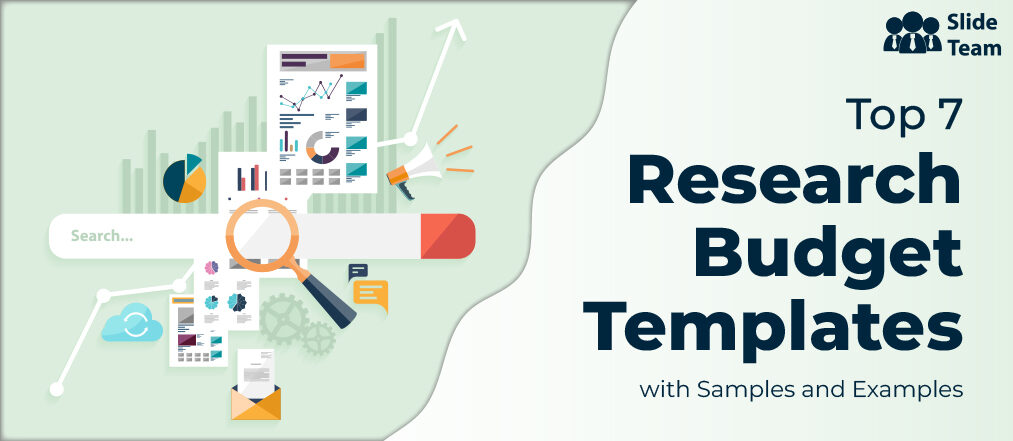
Tejas Prasanna
There is no magic formula for creating a research budget. Depending on the kind of research and the potential changes it can bring about, careful planning and allocation is necessary. Budgets can, thus, vary depending on the sponsors, besides other factors. However, every research budget has some essential guidelines.
Research budgets depend on the project deliverables, timelines, and milestones. The resources required also depend on the scope of the projects and sponsors.
Best Templates for Planning Your Research Budget
Designing a research budget is not easy. You will need to consider the resources required and categorize them according to guidelines to ensure funding is not a problem. The categories may include the project’s necessary supplies and equipment and the wages you must pay your assistants. Research budgets are allocated for a year, but you can also plan for a quarter, depending on the project.
At SlideTeam, we have taken care of all these pain points and designed content-ready presentation templates that address each of these points. You save the time, the resources, and the tedium in having to make these presentations from scratch.
What is even better is that each of the templates is 100% editable and customizable. The content-ready nature means you get a starting point and a structure to guide your presentation; the editability feature means you can customize the template to audience profile.
Let’s explore these templates now.
Template 1 - Impact matrix evaluation research solution budget
This PPT Template is the perfect solution for your research budgeting needs. The matrix suggests what solutions are essential with the help of relevant keys that assign priority levels. Priorities go from low to highest influence with increasing importance. They are color-coded, with white being the lowest and red being the highest influence. For instance, Maintain Awareness and Evaluation are red in many cases, as shown in the slide. So, that means that they bear a significant impact on the research budget. Similarly, Strategic and Budget Planning are color-coded white, which means they don't impact the research budget as much in some cases.
With the impact matrix and heatmap, mapping out your research budget will be a breeze.
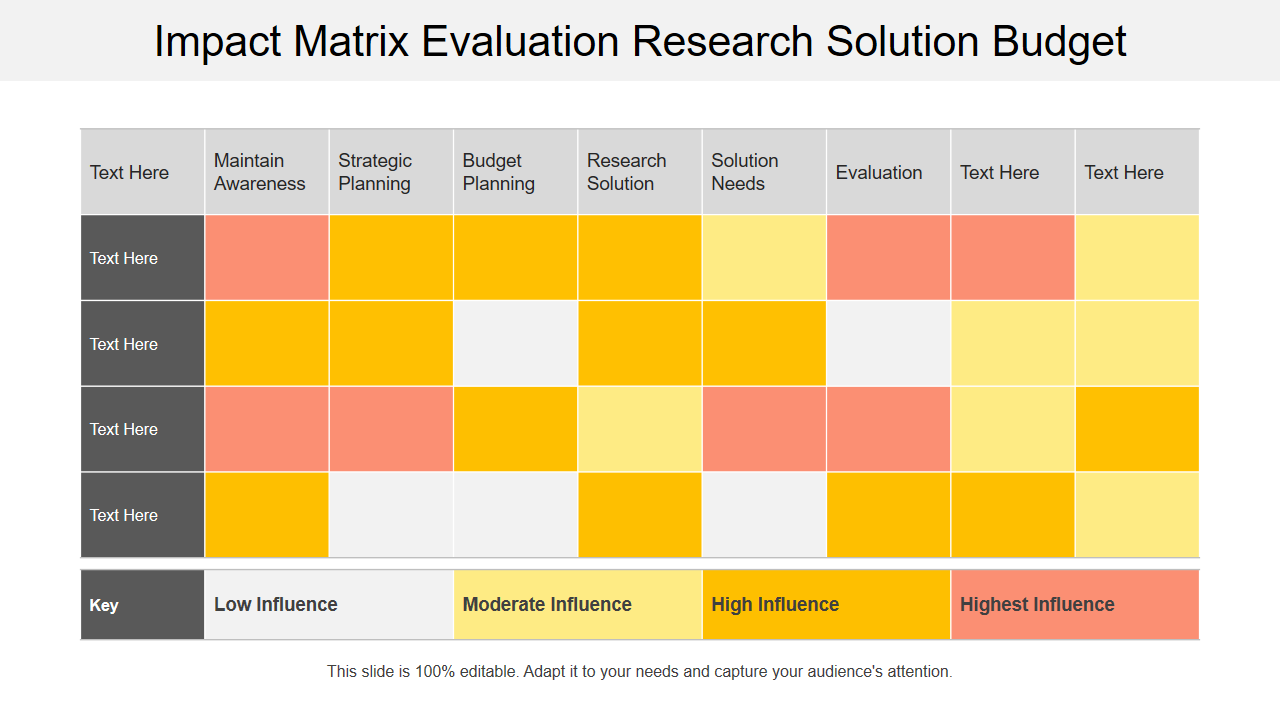
Get it now!
Template 2 Half-yearly research and development departmental budget
Research and Development departments can plan the budget required for projects for the two halves of the year using this PPT Template. The presentation template highlights areas for which you will need funding such as research and development, skills, innovation and patenting, and cooperation. You can also list your requirements for each area. For instance, under R&D and skills, you may need funding for medical research, chemical research, etc. Similarly, for innovation and patenting, you may need funding for product innovation and to cover patenting costs. Likewise, cooperation may involve setting up new laboratories and research centers. With this outlined, you can split the budget required for your research project for the two halves of the year.
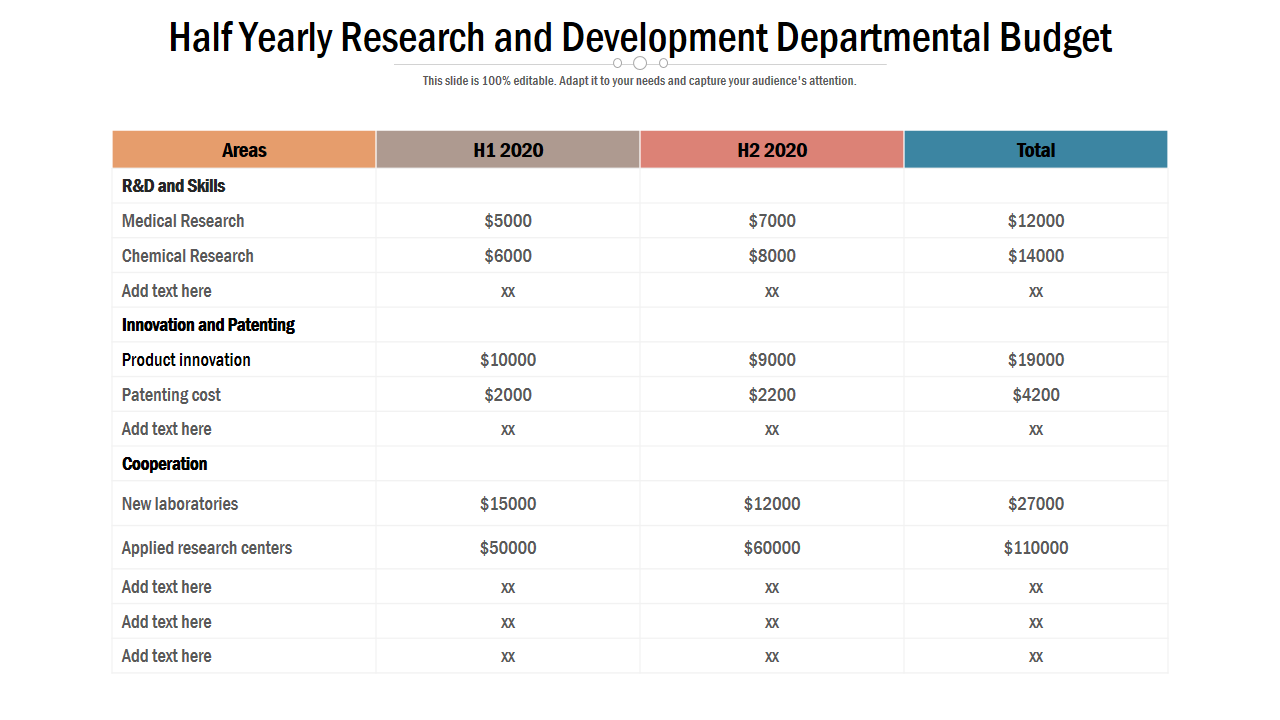
Download now!
Template 3 - Budget Estimate for Research and Development Project
This presentation template for the budget estimate for your research and development project is apt for arriving at the calculation for the four quarters in a year. You can define and assign tasks as per the requirements of the project and allocate a set budget for each. The tasks may involve conducting market research and competitive analysis or be innovative or developmental. In either case, you can use this template to set a fixed budget for each task in the research project.
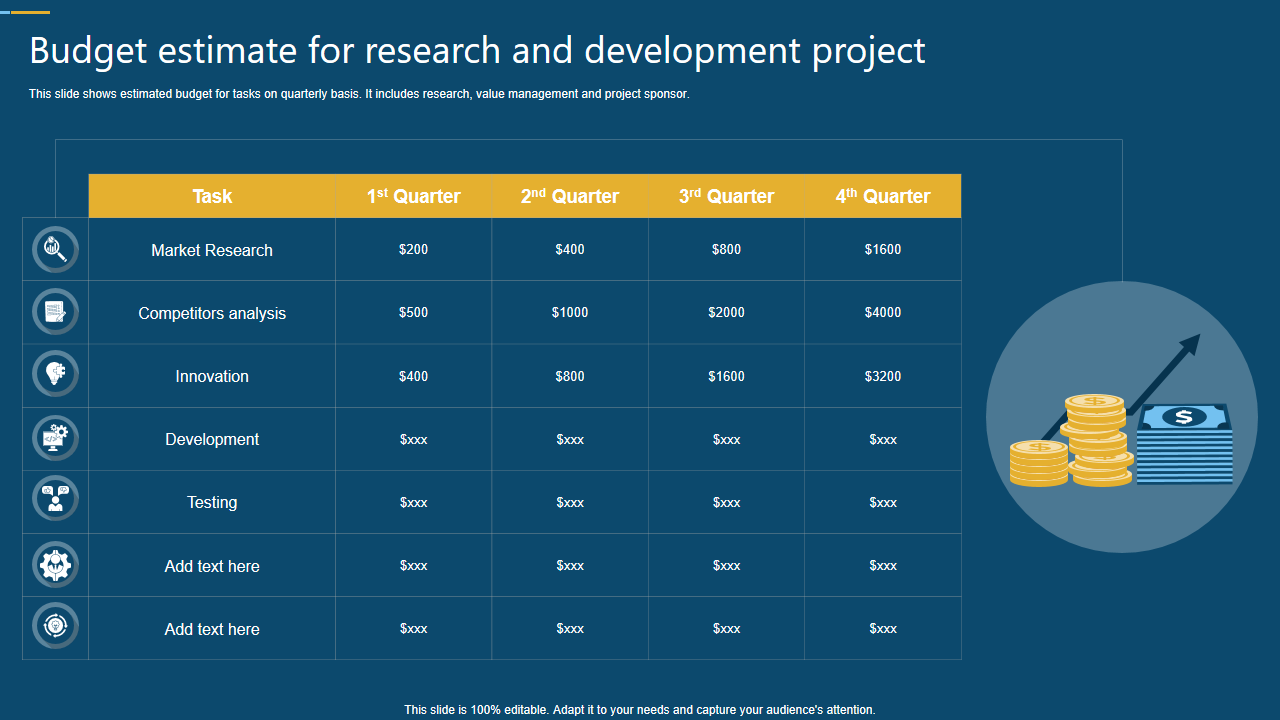
Get it today!
Template 4 Clinical Trial Phases with Communication and Budget Research Design for Clinical Trials
Clinical trials involve many phases, and you should let your research associates know about each step. For instance, you could post the information on the company website and provide relevant insights during the pre-trial phase. Similarly, you can offer the welcome letter and training materials during the trial start-up. During the trial, you can send newsletters to your associates, giving them relevant information and other valuable insights. All this requires funding, and you will need to allocate a budget. However, you don't need to worry, as this PPT Preset has you sorted, with dedicated sections for the pre-trial, trial start-up, during-trial, and trial-end phases. It also has communication, insights summary, and budget sections. You can use the budget section in the matrix to allot a budget for each trial phase and each section, including communication and insights.
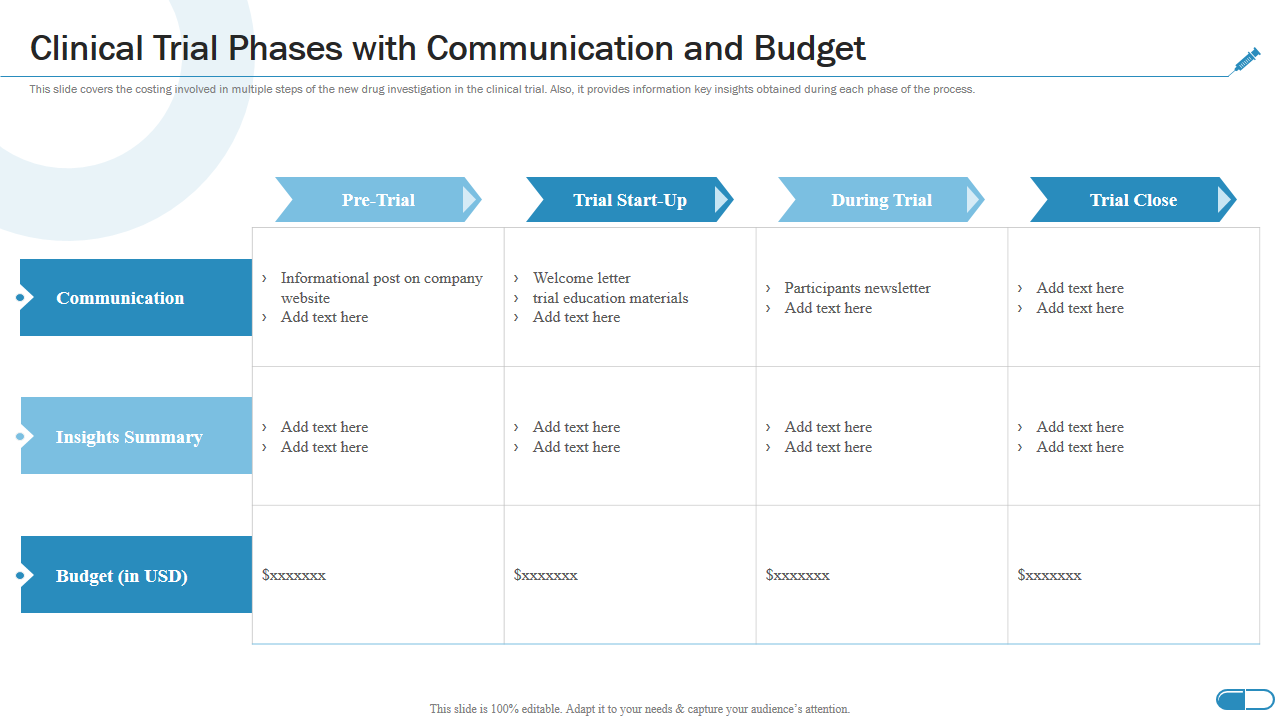
Download here!
Template 5 Market research strategy with budget and area
The PPT Template has all the core elements required for your market research strategy, including the budget and area. This slide lets you list your clients, the items, and when to send them. You can also list background information related to your research, the aim and objectives of the project, the areas covered, and the budget.
The presentation template also provides a dedicated space to list your brands and products and a timeline for completing the research.
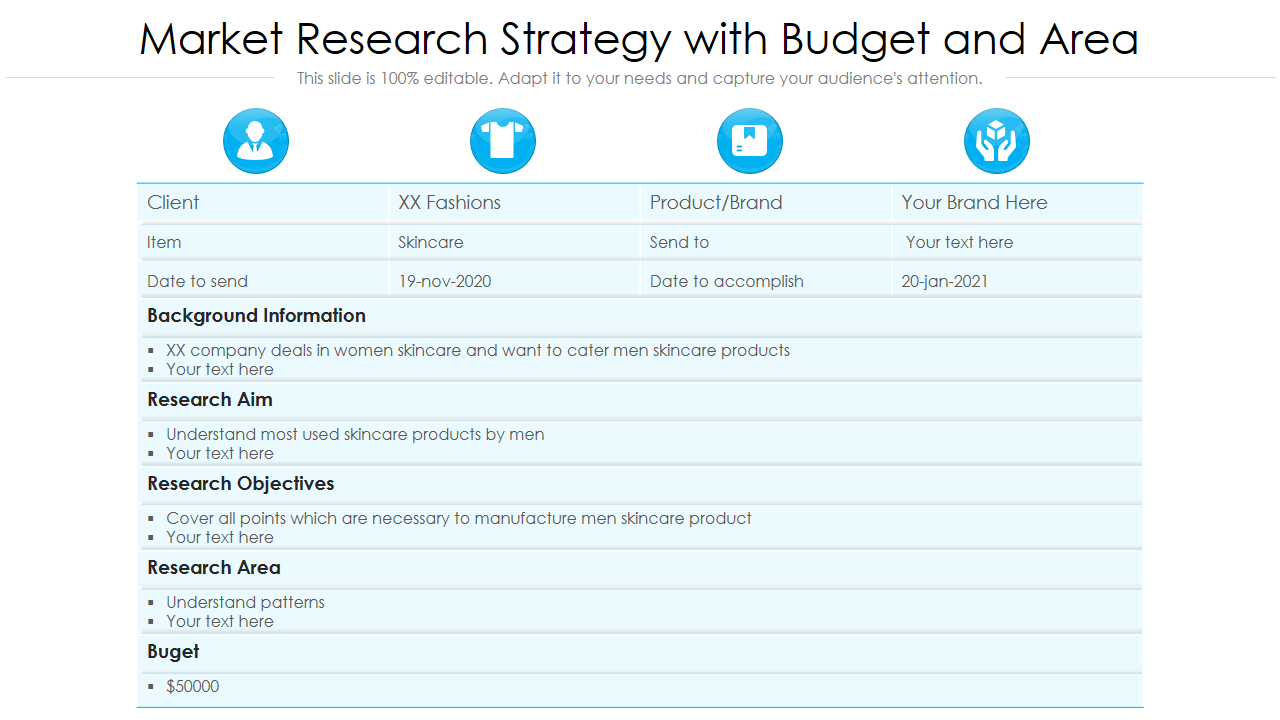
Template 6 - Determine Budget for Psychology Research Proposal One-Pager Sample Example Document
This presentation template is an easy-to-use tool for determining the budget required for psychology research. With this slide, you can allocate a budget for each area, including diagnostic assessment, training, technology and tools, supplies, travel, and workforce. It is a practical, hands-on template with information required to plan the budget for conducting psychological tests and evaluations. Please note that depending on your geography, taxes might or might not deserve a separate column.
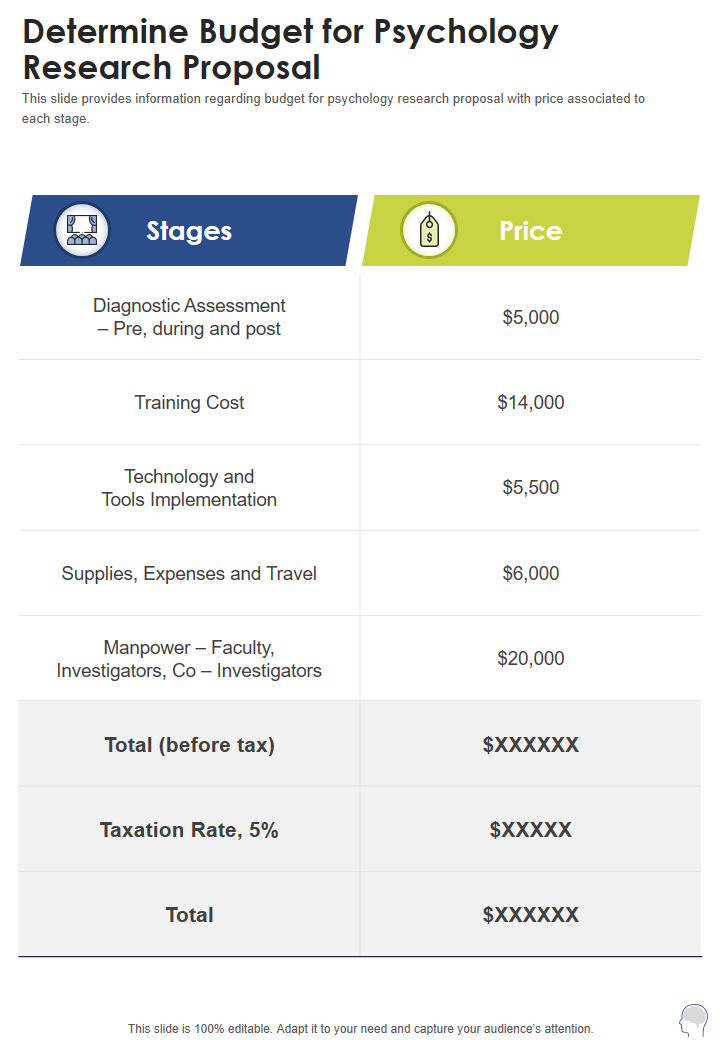
Template 7 - Budgeting for Product Launch Market Research
Every company needs to conduct market research before launching a new product. The PowerPoint Presentation that you have here can help you plan the budget required for conducting such market research. It includes necessary information, including business and research objectives, priorities, methodologies, and forecasts. The presentation template also has the metrics required for the research, such as improving customer engagement, introducing new products, and increasing market share. For example, to improve customer engagement, you may be looking to improve marketing approaches and gather customer feedback. The methods you may use include conducting marketing mix studies and tests. Similarly, you may want to optimize your social media posts and profiles and conduct A/B tests when introducing new products. Improving your market share may involve analyzing the competition. You may even use this handy template for conducting market research, estimating, and forecasting budgets.
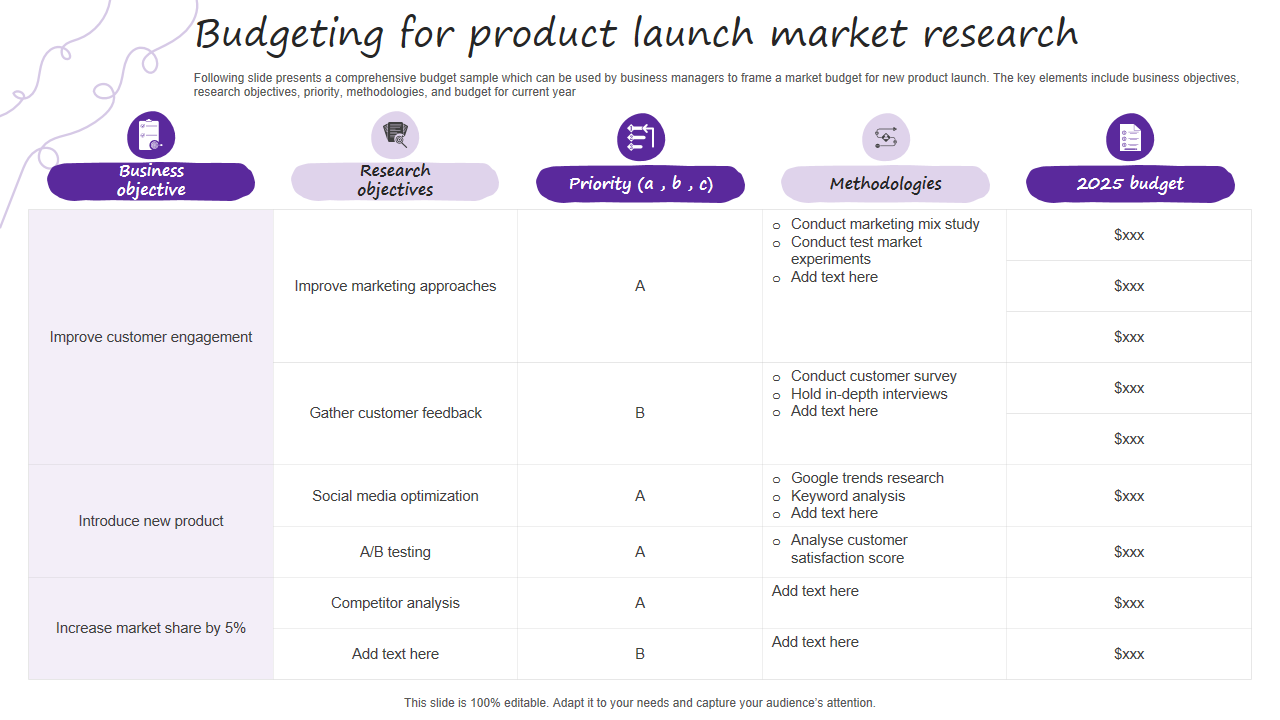
RESEARCH IS IMPORTANT BUSINESS
You can plan your research and the budget required using these templates. Remember that each new product launch has lots of research behind it. When going for a new launch, don’t just research the products and its uses, but also the markets – particularly, your target audience and how they will benefit from your brands. When allocating the budget for your research, don't forget to note your total resources and try to be as cost-effective as possible. You must consider the expected costs that you may incur and use these templates to work out a research budget that fits within your resources.
FAQs on Research Budget
What should be included in a research budget.
Research budgets should include all direct costs, and facilities and administrative costs (F&A). The facilities and administrative expenses are needed to achieve the primary objectives of the research. The project description should state the proposed budget and serve as a financial expression for the research. The idea is to ensure that the budget is comprehensive.
How do you create a research budget?
You can create a simple research budget by following these steps:
- List activities that will help you carry out the research.
- Check the rules for getting the funding required.
- Check all costs involved.
- Lay out the costs using a spreadsheet.
- Justify your budget by asking why and for what you need the money and where you got your figures.
What is the role of budget in research?
A budget can provide a detailed and clear picture of the structure of the research project, not to mention that it also lets you know how well it can be managed. The research project budget usually lets you see whether it will go according to plan and if it is feasible. So, it must be complete and reasonable.

What is the average budget for a research project?
The budget for a research project depends on the type of research and the proposed difference it could make to a field of study. For instance, the average budget for a market research project may vary between $20,000 and $50,000. Similarly, larger scientific research projects may cost millions or even billions of dollars, as in pharmaceuticals.
Related posts:
- Top 5 Startup Budget Templates with Samples and Examples
- Top 5 Construction Project Budget Templates With Examples And Samples
- Top 10 Cost Comparison Templates with Examples and Samples
- Top 5 Budget Planner Templates with Examples and Samples
Liked this blog? Please recommend us

Top 10 Purchasing Process Example Templates with Samples

Top 10 Banking Company Profile Templates for Crafting a Profile that Makes Money Talk!
This form is protected by reCAPTCHA - the Google Privacy Policy and Terms of Service apply.

Digital revolution powerpoint presentation slides

Sales funnel results presentation layouts
3d men joinning circular jigsaw puzzles ppt graphics icons

Business Strategic Planning Template For Organizations Powerpoint Presentation Slides

Future plan powerpoint template slide

Project Management Team Powerpoint Presentation Slides

Brand marketing powerpoint presentation slides

Launching a new service powerpoint presentation with slides go to market

Agenda powerpoint slide show

Four key metrics donut chart with percentage

Engineering and technology ppt inspiration example introduction continuous process improvement

Meet our team representing in circular format

Sample budgets
Justification.
Bumblebee colonies will be obtained from Koppert Biological Systems (MI, USA) and shipped overnight to Nevada. An emerging standard for publication is the utilization of three to five colonies for testing so as to minimize individual colony biases and to acquire a sufficient data set. In order to maintain the colonies I will need pollen to feed them on a daily basis. Additionally I will use the chemical octopamine hydrochloride to explore neuroendocrine relationships between gustatory responsiveness, learning, and octopamine.
I estimated shipping costs to the best of my knowledge.
* Costs are estimated based on average costs of the material; final cost may be slightly different.
Budget Justification
A well-developed budget is accompanied by a budget explanation or narrative, also known as a budget justification. A complete and realistic budget justification demonstrates that your project is well conceived. It also tends to minimize the chances that sponsors will arbitrarily reduce or eliminate budget categories. Sponsors have a good idea of what a project should cost, and generally know when you are over or under budgeting. See some examples/templates below .
The budget is reviewed by OPAS and the sponsor to verify that costs are reasonable, allowable, allocable and necessary to carry out the proposed project, and if it conforms to the sponsor's instructions. During award negotiations a budget is sometimes subjected to further analysis by the sponsor's audit staff. Thus it is important to maintain all the documentation and justification you can assemble for each cost element and category, in case the sponsor questions items and estimates.
For newcomers to the process, consult with experienced faculty or staff within your department for advice, or contact the OPAS pre-award administrator assigned by sponsor to discuss potential costing.
The budget justification is a categorical description of the proposed costs. Generally, it explains staffing and supply/service consumption patterns, the methods used to estimate/calculate (including escalation or inflation factors) and other details such as lists of items that make up the total costs for a category. The budget justification should address each of major cost categories (salaries, fringe benefits, equipment, travel, supplies, other direct costs and indirect costs), as well as any additional categories required by the sponsor.
A thoroughly written justification that explains both the necessity and the basis for the proposed costs must accompany the budget. The justification section is critical as it enables the principal investigator to emphasize the importance of essential project costs. A budget that is adequately and appropriately justified is the best way to assure a positive cost analysis by the sponsor.
Below are some helpful tips:
- Organize the budget justification listing items in the same order and format as the sponsor’s budget categories.
- Only include budgeted items. Some sponsors like NSF will disqualify a proposal if contributed items are listed. Do not list cost-shared items unless cost-sharing is mandated by the sponsor.
- Budget narrative must match the budget in terms of dollar amounts and language – double check everything.
- Explain why items are essential in relation to the aims and methodology of the project as well as meeting the goals of the project.
- Explain the line items. Do not merely restate the proposed expenditure.
- Provide detail sufficient to justify the rationale for acquiring the item under the proposed project.
Budget Justification Examples and Templates
NSF Budget Justification example
NIH Budget Justification example
Budget Justification For Any Sponsor
Salaries and Wages
Also see Budget Development: Personnel Costs .
- List all personnel and positions to be paid with project funds and briefly describe their role in the project.
- Only list paid personnel unless cost-sharing is mandated by the sponsor.
- In addition to how the sponsor requires effort to be shown, also always list effort in person months for faculty and staff. For Graduate Research Assistants, list number of months and hours per week.
- When listing effort, do not use approximations. Show effort out to two decimal points (e.g. 1.52 months) as applicable.
- Include a COLA of 3% to 5%. Verify any sponsor-driven limitations on COLAs. Currently for example, UMass budgets only 2% with the NIH.
Consultants
Also see Budget Development: Consultants .
- List consultant name and describe in detail the services to be performed.
- Include number of days, rate of compensation, and total amount per year. This must be corroborated in a letter provided by the consultant.
Also see Budget Development: Equipment .
- Definition of Equipment : a unit cost of $5,000 or more and a useful life of at least one year.
- Get accurate price quotes
- Explain why the equipment is needed in support of the project aims.
- Confirm equipment is dedicated to the project. If equipment is shared with other projects, budget an amount that corresponds to expected project use and verify the rationale. Split funding of equipment should only generally occur with large equipment purchases.
Materials and Supplies
Also see Budget Development: Materials and Supplies .
- Only request supplies directly relevant (allocable) to the research plan.
- Explain in detail why specific supplies are needed.
- Do not request general office supplies if federal (allowability).
- Budgeting should be based on actual experience or quotes (reasonableness).
- Use an inflation factor (COLA) for future years (verify any sponsor limits).
- The breakdown should be more detailed when the total supplies cost is substantial. Where large amounts of supplies or expensive items are budgeted, specify items and justify their necessity.
Also see Budget Development: Travel .
- Ask for reasonable amounts.
- Indicate basis of cost (historical, quotes, etc.)
- State exactly which relevant meeting/conference you plan to attend. If not known, provide examples.
- Include breakdown of costs for airfare, meals, lodging, and ground transportation. Some sponsors like NSF will reject a proposal if insufficient details are provided.
- Include number of people, number of days, purpose and location of travel.
- Budgeting should be based on actual experience or quotes.
- Use an inflation factor (COLA) for future years.
- Avoid partial financing of travel requirements.
Other Direct Costs
See also Budget Development: Other Direct Costs .
- Fee-for-service: Justify use; show the University approved rate, or if an external vendor, their published rate. (internal link here to “Fee-for-service)
- Equipment maintenance and service contract (justify need) and verify that the covered equipment is dedicated to the project; If proportional use on the covered equipment is anticipated, provide the proportional cost/use rationale; Cost/usage should not generally fall below 50%; Note the basis of the cost (quotes, etc.)
- Software should be identified by brand, type, and unit cost; verify in the justification that it is dedicated to the project; and provide a strong justification for why it is needed especially emphasizing what aspect of the project will benefit from its use; the software should not be general purpose software but rather specialized in a manner that supports the specific technical aims of the project; verify basis of cost (quotes, catalog prices, etc.) (link to software costing info above)
- Human Subject Payments (breakdown # of subjects and cost to each)
- Provide details for publication costs.
- Give detailed breakdown of each cost.
- Tuition – provide details. See the Fact Sheet for current rates and provide them to the sponsor. Use the Kuali Salary Guide (Excel) .
Subcontractors/Subrecipients
See also Budget Development: Subcontracts .
- Clearly identify subcontracting organizations and their key personnel.
- Briefly explain their scope of work.
- Explain the need to contract with a particular organization, expertise of subcontractor PI, institutional facilities.
- Keep in mind that subcontractors will provide their own detailed budgets and corresponding budget justifications. These should be separate and distinct from the UMass budget and budget justification and follow the UMass budget and budget justification.
Search form
©2024 University of Massachusetts Amherst • Site Policies • Site Contact
- Research Portal
- Award Lifecycle
- Find Funding
- Develop and Submit Proposal
- Set Up Project
- Manage Project
- Project Closeout
- Research Compliance
- Fiscal Compliance
- Policies and Guidance
- Research Education
- Systems/Portals
- SPARCS Staff Contacts
- C and G Staff Contacts
- College and Unit Research Contacts
Budget Templates
Nc state budget templates.
Unity ID Required
- Budget (Modeled from NSF template)
- Budget Justification
- Budget – Detail Version
- Budget – Summary Version
Sponsor-specific Budget Templates
Nih modular budget guidelines.
The modular grant is an NIH effort to streamline the proposal submission process. It is intended to focus the attention of investigators, their institutions, peer reviewers and NIH staff on science rather than budget details. It applies to research grant applications requesting up to $250,000 per year in direct costs.
US Department of Energy
Department of Energy Assistance awards announced in Funding Opportunity Announcements (FOA) typically require the completion of a PMC 159 Budget Justification form. This is a multi-worksheet Excel workbook, wherein each worksheet represents a different type of cost (Labor, Fringe Benefits, Equipment, Subcontracts, Indirect Costs). Each individual sheet must be completed and the totals generated on each sheet are linked to a summary budget display and a proposal budget form Standard Form 424A. This format was prepared for commercial entities, where labor costs are based upon set labor categories, labor rates and estimated labor hours. It also includes multiple forms of indirect cost calculations, instead of the single indirect cost (F&A) calculation used by universities.
In order to provide an accurate record of how cost estimates are prepared at NC State and to include explanations of the differences, it is recommended to use the PMC 159 customized form . It includes a representation of our standard cost reimbursement budget display on a tab titled “CAS Institutional Bgt”. It also contains a tab titled “Basis of Costs”, which explains the differences in how our costs are estimated. The tab titled “a. Personnel” has been modified to reflect estimated salaries based upon percent of effort, and annual or monthly salary amounts. All references to labor rates and labor hours have been removed. When using this form of the workbook, it is recommended to start by completing the CAS Institutional Bgt worksheet first, to ensure that an accurate estimated budget is prepared. This version also includes three optional worksheets to capture more details of proposed travel expenses (domestic and foreign), and the totals are linked to a “Travel Summary” tab. These are in addition to the standard tab for travel, which must always be completed. Experience has shown that DOE typically asks for additional detail on proposed travel and these three sheets are designed to easily capture that detail. They may be deleted from the workbook if not used.
- Log in / Register

- Getting started
- Criteria for a problem formulation
- Find who and what you are looking for
- Too broad, too narrow, or o.k.?
- Test your knowledge
- Lesson 5: Meeting your supervisor
- Getting started: summary
- Literature search
- Searching for articles
- Searching for Data
- Databases provided by your library
- Other useful search tools
- Free text, truncating and exact phrase
- Combining search terms – Boolean operators
- Keep track of your search strategies
- Problems finding your search terms?
- Different sources, different evaluations
- Extract by relevance
- Lesson 4: Obtaining literature
- Literature search: summary
- Research methods
- Combining qualitative and quantitative methods
- Collecting data
- Analysing data
- Strengths and limitations
- Explanatory, analytical and experimental studies
- The Nature of Secondary Data
- How to Conduct a Systematic Review
- Directional Policy Research
- Strategic Policy Research
- Operational Policy Research
- Conducting Research Evaluation
- Research Methods: Summary
- Project management
- Project budgeting
- Data management plan
- Quality Control
- Project control
- Project management: Summary
- Writing process
- Title page, abstract, foreword, abbreviations, table of contents
- Introduction, methods, results
- Discussion, conclusions, recomendations, references, appendices, layout
- Use citations correctly
- Use references correctly
- Bibliographic software
- Writing process – summary
- Sample research budget templat…
Sample research budget template
Download sample research budget template
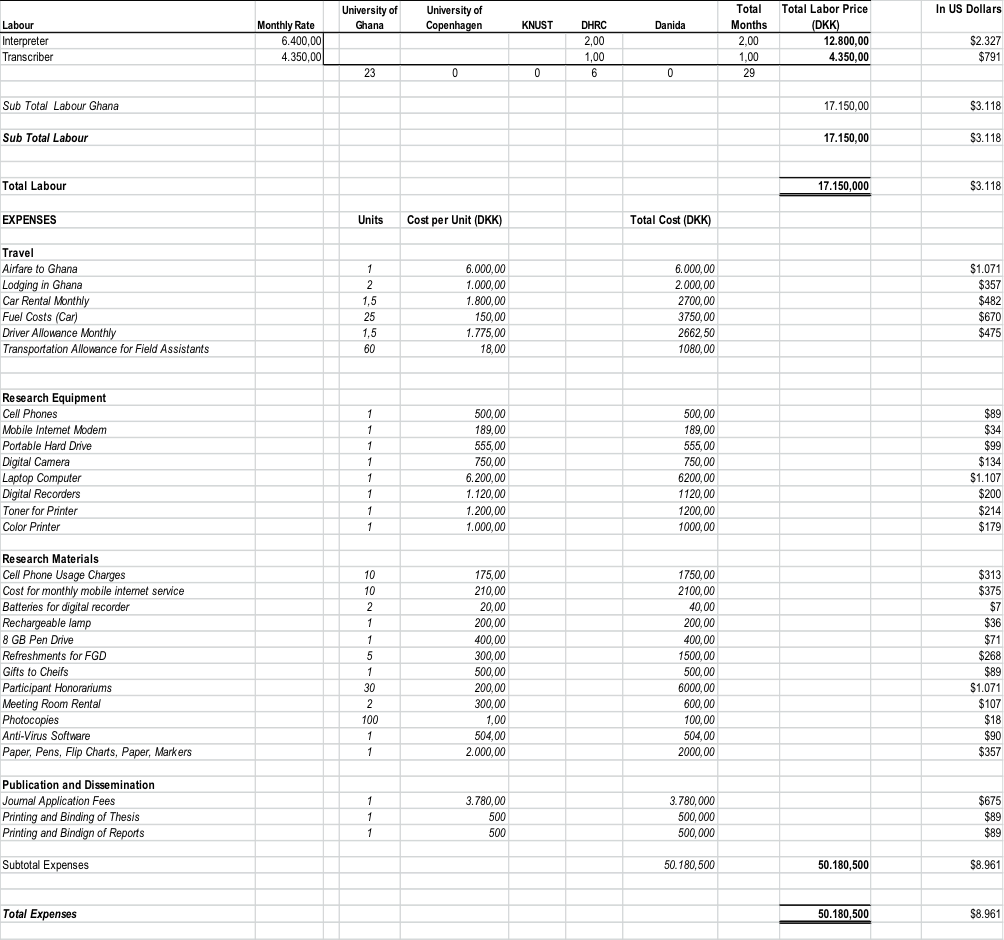
Your friend's e-mail
Message (Note: The link to the page is attached automtisk in the message to your friend)
All Formats
Table of Contents
Proposal template bundle, 12+ research budget proposal templates in pdf | ms word, 1. research budget proposal template, 2. project research proposal and budget, 3. school research budget proposal template, 4. sample student research budget proposal, 5. science research proposal budget form worksheet, 6. free research budget grant proposal template, 7. research paper proposal budget template, 8. research thesis proposal budget example, 9. printable research budget plan proposal.
- 10. Free Business Research
11. Undergraduate Research Budget Proposal Template
12. research budget management proposal format, 13. standard draft research budget proposal template, 14. free research project budget proposal, classification of research proposal budget, how to make a research budget proposal, budget templates, 12+ research budget proposal templates in pdf | ms word | apple pages.
A research proposal is a paper that proposes a research project , usually in the sciences or academia and generally constitutes a funding request for that study. A budget is one of the key components of a research proposal and serves as a blueprint for spending the funds from the project. An effective budget for the proposal outlines the proposed project in fiscal terms and helps reviewers determine how the project is to be carried out.
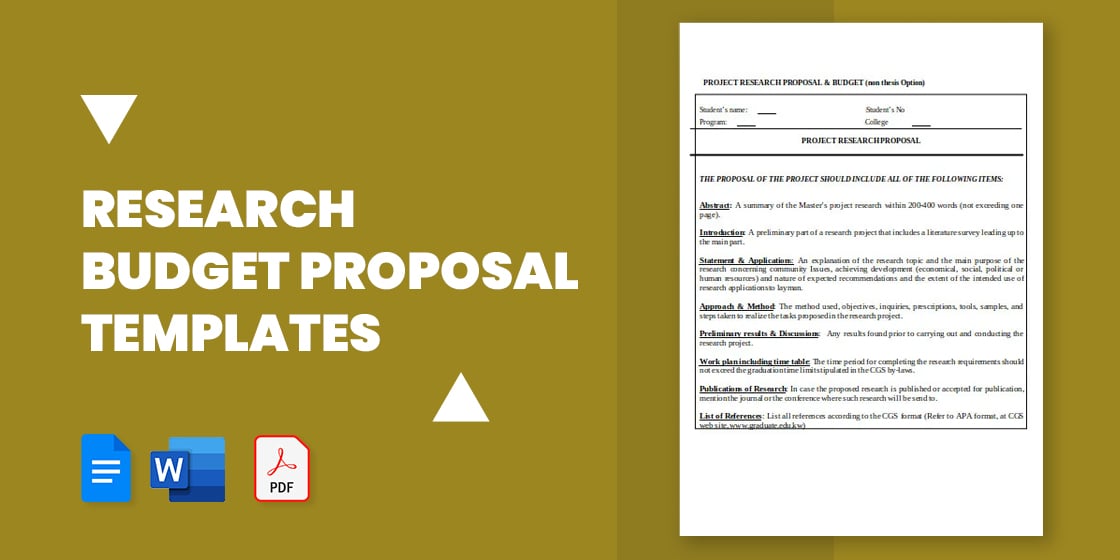
- Google Docs
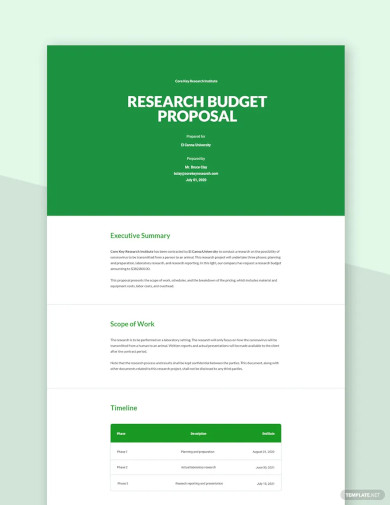
- Apple Pages
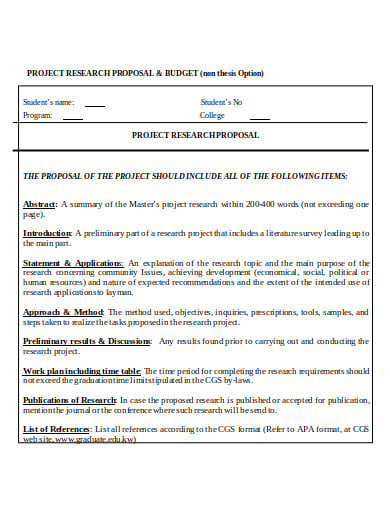
10. Free Business Research Budget Proposal
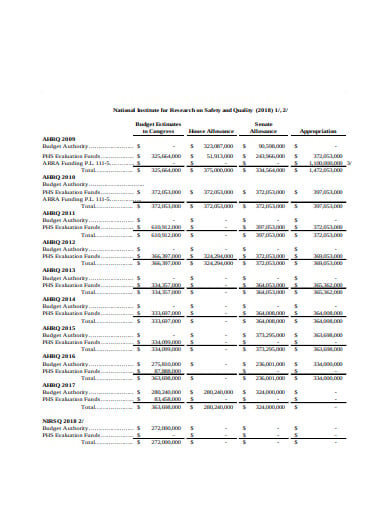
Direct Costs
Indirect costs, 1. list your activities.
- Interviews: 20 in Sydney; 10 in Perth; 15 in Melbourne.
- I’ll need three months of teaching release for fieldwork.
- Flight tickets for travel required.
- Accommodation for at least a month in each place.
- The results will need to be transcribed.
- A research assistant will be required.
2. Check the rules again
3. cost each item, 4. put it in a spreadsheet, 5. justify it, more in budget templates, school sports program brochure template, university research poster template, a3 research poster template, keynote speaker poster template, quartet poster template, quality poster template, conference poster keynote template, research poster template for keynote, school cash management policy template, biography research template.
- 5+ Budget Planner Templates
- 8+ Recruitment Budget Templates in MS Word | PDF
- 7+ Logistics Budget Templates in PDF
- 6+ Retirement Income Calculator Templates in XLS
- 10+ Retirement Budget Planner Templates in PDF | XLS
- 4+ Retirement Budget Spreadsheet Templates in DOC | XLS
- 15+ Sample Renovation Budget Templates – PDF, Docs
- 10+ Non Profit Budget Templates – Word, PDF, Excel
- 10+ Recurring Revenue Templates in Google Docs | Word | Excel | Numbers | Pages | PDF
- 10+ Cost Allocation Templates in Google Docs | Google Sheets | Excel | Word | Numbers | Pages | PDF
- 10+ Net Worth Summary Templates in Google Docs | Google Sheets | Excel | Word | Numbers | Pages | PDF
- 27+ Financial Projection Templates in Google Docs | Google Sheets | Excel | Word | Numbers | Pages | PDF
- 10+ Expense Allocation Templates in AI | Google Docs | Google Sheets | Excel | Word | Numbers | Pages | PDF | Publisher
- 10+ Operating Budget Templates in PDF | Google Docs | Google Sheets | Excel | Word | Numbers | Pages
- 10+ Employee Compensation Plan Templates in Google Docs | Google Sheets | Excel | Word | Numbers | Pages | PDF
File Formats
Word templates, google docs templates, excel templates, powerpoint templates, google sheets templates, google slides templates, pdf templates, publisher templates, psd templates, indesign templates, illustrator templates, pages templates, keynote templates, numbers templates, outlook templates.
How to Write a Budget Proposal (+ Free Template)
Published: May 29, 2024
The first time I was assigned to write a budget proposal, I stared anxiously at a blank spreadsheet, wondering where to begin. What was a budget proposal supposed to include? Was there a specific structure to follow? How could I ensure it met all the necessary criteria?

My early attempts at writing a proposal taught me the challenges of building a convincing plan that turns rough ideas into fundable projects. I had to learn to align proposal details with business objectives and articulate the potential benefits in a way that resonated with stakeholders.

It was an overwhelming task at times — but with a strategic approach and a bit of guidance, my ability to synthesize financial data and communicate value gradually became second nature.
In this article, I'll guide you through how to write a simple budget proposal that delights your audience and secures funding. I’ll also provide practical tips, templates, and sample projects to streamline your planning process.
So, let’s get started.
Table of Contents
What is a budget proposal, and why is it important?
The anatomy of a budget proposal, how to create a simple budget proposal, building my own basic budget proposal, 8 budget proposal best practices.
A budget proposal outlines the financial plans for a project or initiative, detailing the expected costs and resources needed for successful completion.
Budget proposals also show potential funders or stakeholders how their money will be spent and the tangible benefits their investment will achieve.
While the content of your budget proposal will change depending on your project’s parameters and specific goals, a well-crafted plan leads to benefits like:
- Stakeholder buy-in. Providing a transparent breakdown of anticipated expenses instills confidence and trust, encouraging stakeholder support or investment.
- Efficient resource usage. Outlining a clear resource allocation plan ensures that funds are directed to the areas where they are needed most.
- Risk mitigation. Applying a risk management framework helps proactively identify potential costs and contingencies, ensuring that the project remains on track and within budget constraints.
- Project tracking. Identifying key project milestones and benchmarks promotes informed decision-making, maintaining efficient and agile progress.
.png)
Free Business Budget Templates
Manage your business, personal, and program spend on an annual, quarterly, and monthly basis.
- Personal Budget Template
- Annual Budget Template
- Program Budget Template
You're all set!
Click this link to access this resource at any time.
Before you begin drafting your budget proposal, it's helpful to first familiarize yourself with its key components and overarching structure.
Knowing which strategic points to emphasize — and the order in which to present them — improves your ability to create a logical and compelling argument, while also ensuring you effectively communicate your project’s feasibility.
So, let's examine five critical sections found in every effective budget proposal, drawing on the structure used in Hubspot’s Free Budget Proposal Template .
7. Build a story.
Weave in a strong storytelling narrative that provides context, explains assumptions, and addresses any potential concerns or questions. This adds depth to your proposal and helps guide readers through the document.
Pro tip: Incorporate data visualization techniques, such as graphs or infographics, to complement your narrative and enhance the clarity and persuasiveness of your budget proposal.
Don't forget to share this post!
Related articles.
![dissertation budget example How to Manage Your Entire Marketing Budget [Free Budget Planner Templates]](https://blog.hubspot.com/hubfs/adbudget.webp)
How to Manage Your Entire Marketing Budget [Free Budget Planner Templates]

How a Bottom-Up Budget Can Transform Your Company From Bottom to Top
![dissertation budget example Marketing Budget: How Much Should Your Team Spend in 2024? [By Industry]](https://blog.hubspot.com/hubfs/how%20to%20spend%20your%20marketing%20budget_featured.webp)
Marketing Budget: How Much Should Your Team Spend in 2024? [By Industry]

The Best Free Business Budget Templates
![dissertation budget example How Marketing Leaders are Navigating Recession [New Data]](https://blog.hubspot.com/hubfs/how%20marketing%20leaders%20are%20navigating%20recession.webp)
How Marketing Leaders are Navigating Recession [New Data]
![dissertation budget example 3 Ways Marketers are Already Navigating Potential Recession [Data]](https://blog.hubspot.com/hubfs/how-marketers-are-navigating-recession.jpg)
3 Ways Marketers are Already Navigating Potential Recession [Data]
![dissertation budget example Marketing Without a Budget? Use These 10 Tactics [Expert Tips]](https://blog.hubspot.com/hubfs/marketing%20without%20budget.jpg)
Marketing Without a Budget? Use These 10 Tactics [Expert Tips]

24 Ways to Spend Your Marketing Budget Next Quarter

Startup Marketing Budget: How to Write an Incredible Budget for 2023

10 Best Free Project Management Budget Templates for Marketers
6 templates to manage your business, personal, and program spend on an annual, quarterly, and monthly basis.
Marketing software that helps you drive revenue, save time and resources, and measure and optimize your investments — all on one easy-to-use platform

IMAGES
VIDEO
COMMENTS
Steps to Take to Create Your Budget. 1. Consult Your Adviser, Committee Members, and Funding Sources for Guidelines. The source or sources responsible for funding your dissertation research will likely have guidelines on what is and isn't a billable expense. Before defining your projected costs, check your funding organization's ...
A good budget shows the assessors that you have thought about your research in detail and, if it is done well, it can serve as a great, convincing overview of the project. Here are five steps to create a simple budget for your research project. 1. List your activities. Make a list of everything that you plan to do in the project, and who is ...
What is a Proposal Budget and why is it needed? Before we get started talking about all the pieces of a budget, let's make sure that we're on the same page about what a budget actually is. A budget is a financial proposal that reflects the work proposed. It outlines the expected project costs in detail, and should mirror the project description.
Costs for Project Budgets - Appendix C. The budget justification is one of the most important non-technical sections of the proposal, and it is often required by the sponsor. In this section, the Principal Investigator (PI) provides additional detail for expenses within each budget category and articulates the need for the items/expenses listed.
Sample Budget Justifications. Sponsor requirements differ, and sample budget justifications should be seen only as a starting point. Guidelines for sponsor requirements are in the annotated budget justifications. Read the solicitation and the sponsor's proposal preparation guidelines for each proposal's requirements.
Sample Research project budget Please use the budget breakdown to justify your project costs. Provide line by line information, adding rows where required, for each cost that is specific to your project. We strongly advise that you refer to the budget guidance in the 'Guidelines for applicants' manual before completing your project budget.
Craft a convincing dissertation or thesis research proposal. Write a clear, compelling introduction chapter. Undertake a thorough review of the existing research and write up a literature review. Undertake your own research. Present and interpret your findings. Draw a conclusion and discuss the implications.
A budget is a financial proposal that reflects the work proposed. It outlines the expected project costs in detail and should mirror the project description. A budget is presented as a categorical list of anticipated project costs representing the researcher's best estimate of the funds needed to support the proposed work.
Make sure you can ask the critical what, who, and how questions of your research before you put pen to paper. Your research proposal should include (at least) 5 essential components : Title - provides the first taste of your research, in broad terms. Introduction - explains what you'll be researching in more detail.
While a thesis proposal is often only 3-7 pages long, a prospectus for your dissertation is usually much longer, with more detailed analysis. Dissertation proposals can be up to 25-30 pages in length. Note Sometimes, a research schedule or detailed budget may be necessary if you are pursuing funding for your work. Dissertation prospectus examples
For example, you are developing a budget for a funding opportunity with an indirect cost rate of 25%. Your direct costs are $201,000 broken down by expense categories shown in the second column of the table below. The third and fourth colums present the two ways you can include the 25% overhead in your budget using the Price Model or the Cost ...
Advice on how to complete your budget: Expenditure should, as far as possible, be given in units (hours, trips, kilometres etc.) For example, salaries can be calculated against full time equivalents or per hour according to qualifications. These are the standard categories in a research budget and each category can have many line items ...
The sample budget template was conceived and created by a team of department administrative managers and OSP staff with the goal of helping researchers and support staff develop sponsored project proposal budgets. For more information about developing budgets see the Overview of Costs for Project Budget page. 13. Process. Budget, Costs, and Rates.
This presentation template is an easy-to-use tool for determining the budget required for psychology research. With this slide, you can allocate a budget for each area, including diagnostic assessment, training, technology and tools, supplies, travel, and workforce. It is a practical, hands-on template with information required to plan the ...
Example research proposal #2: "Medical Students as Mediators of Change in Tobacco Use" Title page. Like your dissertation or thesis, the proposal will usually have a title page that includes: The proposed title of your project; ... Budget. If you are applying for research funding, chances are you will have to include a detailed budget. ...
Medical Research Budget Template. researchamerica.org. Download. A research proposal budget sample is in many ways similar to the research budget sample, only that at this stage, it is still a proposal. This sample is often written in a linear or tabular format and it details all the expenses that are associated with the proposal project.
Misc. funding is for unexpected expenses. $60. Total. $987.94. I estimated shipping costs to the best of my knowledge. * Costs are estimated based on average costs of the material; final cost may be slightly different. View examples of budgets for undergraduate research proposals at the University of Nevada, Reno.
Dissertation Planner: step-by-step. This planner is designed to help you through all the stages of your dissertation, from starting to think about your question through to final submission. At each stage there are useful prompts to help you plan your work and manage your time.
A well-developed budget is accompanied by a budget explanation or narrative, also known as a budget justification. A complete and realistic budget justification demonstrates that your project is well conceived. It also tends to minimize the chances that sponsors will arbitrarily reduce or eliminate budget categories. Sponsors have a good idea of what a project should cost, and
What Is a Research Budget? A research budget showcases the allocated expenses in research, and it is usually represented in tables or charts. Oftentimes, the research budget is discussed twice: (1) it is used to discuss the overall budget plan for a grant or research proposal in case an organization approves of funding the research budget, and (2) it displays the associated expenses involved ...
NIH Modular Budget Guidelines. The modular grant is an NIH effort to streamline the proposal submission process. It is intended to focus the attention of investigators, their institutions, peer reviewers and NIH staff on science rather than budget details. It applies to research grant applications requesting up to $250,000 per year in direct costs.
Sample research budget template. Download sample research budget template ...
A research proposal is a paper that proposes a research project, usually in the sciences or academia and generally constitutes a funding request for that study. A budget is one of the key components of a research proposal and serves as a blueprint for spending the funds from the project. An effective budget for the proposal outlines the proposed project in fiscal terms and helps reviewers ...
Using HubSpot's Budget Template, I developed a basic marketing campaign proposal for how my company could leverage social media influencers to promote our product's new language availability options. I started by honing in on the project scope and identifying the target audience — French, German, and Spanish speakers — focusing on how ...
The nonpartisan Urban-Brookings Tax Policy Center think tank, which analyzed Biden's never-implemented budget proposals for fiscal 2024, found this: "His plan would raise average after-tax ...